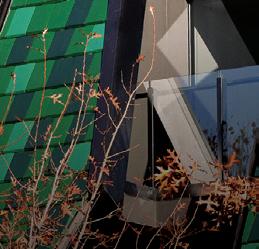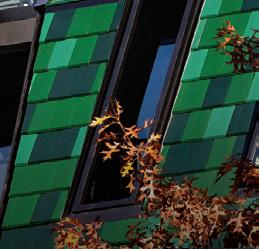
Visibuild isn’t following the blueprint – it’s crafting a bold new approach to construction quality management. Directors Damien Quinn and Ryan Treweek reveal how they’re driving change.













Visibuild isn’t following the blueprint – it’s crafting a bold new approach to construction quality management. Directors Damien Quinn and Ryan Treweek reveal how they’re driving change.














out efficiency
Find out how Topcon technology is boosting productivity for Universal Civil Contracting Brisbane.
8 Laying the foundations of quality
Visibuild outlines its mission to make quality the cornerstone of every construction project.
44 Hala Taouk: Embracing authenticity
Discover how Hala Taouk, senior commercial manager at CIMIC Group’s UGL, embraced authenticity to carve her path in the construction industry.
ASSOCIATIONS
46 Collaboration over conflict
The Australian Constructors Association announces the return of its groundbreaking forum.
48 Streamlining excellence
The National Precast Concrete Association Australia highlights Ozcast’s contribution to the Princes Highway Upgrade.
50 Let’s do this
Empowered Women in Trades prepares for a transformative 2025, championing progress and opportunity.
52 A year of advocacy
The National Association of Women in Construction reflects on a huge year of advocacy achievements.
54 Building dreams
Learn how NexGen’s primary program is shaping the next generation of construction pioneers.
56 Grounded self-leadership
Dr Gretchen Gagel explores how understanding purpose, values and self-awareness shapes the foundation for effective leadership.
Certified to perform
Hobson Engineering underscores the importance of European Technical Assessment approvals in construction.
Pumping possibilities
Jacon Equipment presents its concrete pumping and shotcrete solutions, designed to tackle every construction challenge.
A true supporting act
Light gauge steel framing made from TRUECORE steel shapes The Round performing arts centre’s striking masonry façade.
Building beyond boundaries
Komatsu details how merging technology and smart machinery with expertise enhances productivity, sustainability and safety on worksites.
Winslow shares its sustainable construction innovations and insights to drive broader change across the industry.
Viva Energy showcases the practicality and environmental benefits of renewable diesel.
A blueprint for the future of urban living
Upper House, a 5 Star Green Star rated multi-residential tower, introduces a new way of inhabiting cities. 58 Instrumentation sector joins Converge
VEGA Australia reveals the measurement solutions and expertise it will showcase at Converge 2025.
As 2025 unfolds, the construction industry stands poised at the intersection of innovation, sustainability and quality.
It is time to build on the progress made in 2024 – a year defined by growth in equality, safety, productivity and a commitment to a greener future.
Reflecting on these milestones, the Inside Construction team applauds the collective efforts of industry leaders who tackled challenges headon, driving meaningful change. Now, the focus shifts to what lies ahead – the bold ideas, transformative projects and emerging technologies that will shape the next chapter in construction.
Sustainability remains the cornerstone of industry conversations, and its momentum continues to grow. As a media partner of the Green Building Council of Australia’s flagship conference, TRANSFORM 2025, this edition takes a closer look at how organisations are reshaping construction’s environmental footprint.
Among the highlights, we feature an Australian energy company breaking ground with renewable diesel, helping contractors cut emissions and take practical steps toward decarbonisation. A civil construction firm shares its journey of embedding sustainability into practice, and we explore a 5 Star Green Star rated multi-residential tower that is redefining urban living with its forward-thinking design.
The shift toward greener construction extends to equipment innovation. From electric excavators to hydrogen-powered machinery, a global manufacturer is unveiling solutions to meet the demands of a changing world. Simultaneously, advancements in concrete pumping, spraying and transportation are driving efficiency and sustainability across the sector.
Quality, often overlooked, takes centre stage in this edition. One
technology company shares its mission to elevate quality as the foundation of every construction project, challenging long-held assumptions and positioning it as a core pillar of industry progress.
This issue, we also highlight the inspiring journey of a senior commercial manager working on a transmission project delivering renewable energy to Australian households. Her story celebrates authenticity and leadership, illustrating how standing out can create meaningful impact.
Our Association Partners are also gearing up for a big year. The Australian Constructors Association announces the return of its influential forum; the National Association of Women in Construction continues its advocacy work; and Empowered Women in Trades pushes toward its ambitious vision of 30 per cent female participation in trade-based roles by 2030. NexGen shares insights on its primary program, and the National Precast Concrete Association Australia highlights a landmark highway upgrade.
Inside Construction is proud to be part of these conversations and innovations shaping the future of the industry. We hope this edition inspires, informs and energises you as we embark on another year of progress together.

Chief Executive Officer John Murphy
Chief Operating Officer Christine Clancy
Managing Editor Mike Wheeler mike.wheeler@primecreative.com.au
Editor
Ashley Grogan ashley.grogan@primecreative.com.au
Sales Director
Brad Buchanan bradley.buchanan@primecreative.com.au
Design Caterina Zappia
Head of Design Blake Storey blake.storey@primecreative.com.au
Business Development Manager
Nhung Nguyen nhung.nguyen@primecreative.com.au p: +61 0412 845 608
Client Success Manager Louisa Stocks louisa.stocks@primecreative.com.au
Cover image credit Kristoffer Paulsen
Head Office
Prime Creative Pty Ltd 379 Docklands Drive, Docklands, Victoria 3008 Australia p: +61 3 9690 8766 enquiries@primecreative.com.au www.insideconstruction.com.au
Subscriptions
+61 3 9690 8766 subscriptions@primecreative.com.au
Inside Construction is available by subscription from the publisher. The rights of refusal are reserved by the publisher
Articles
All articles submitted for publication become the property of the publisher. The Editor reserves the right to adjust any article to conform with the magazine format.
Copyright
Inside Construction is owned by Prime Creative Media and published by John Murphy. All material in Inside Construction is copyright and no part may be reproduced or copied in any form or by any means (graphic, electronic or mechanical including information and retrieval systems) without written permission of the publisher. The Editor welcomes contributions but reserves the right to accept or reject any material. While every effort has been made to ensure the accuracy of information, Prime Creative Media will not accept responsibility for errors or omissions or for any consequences arising from reliance on information published. The opinions expressed in Inside Construction are not necessarily the opinions of, or endorsed by the publisher unless otherwise stated.
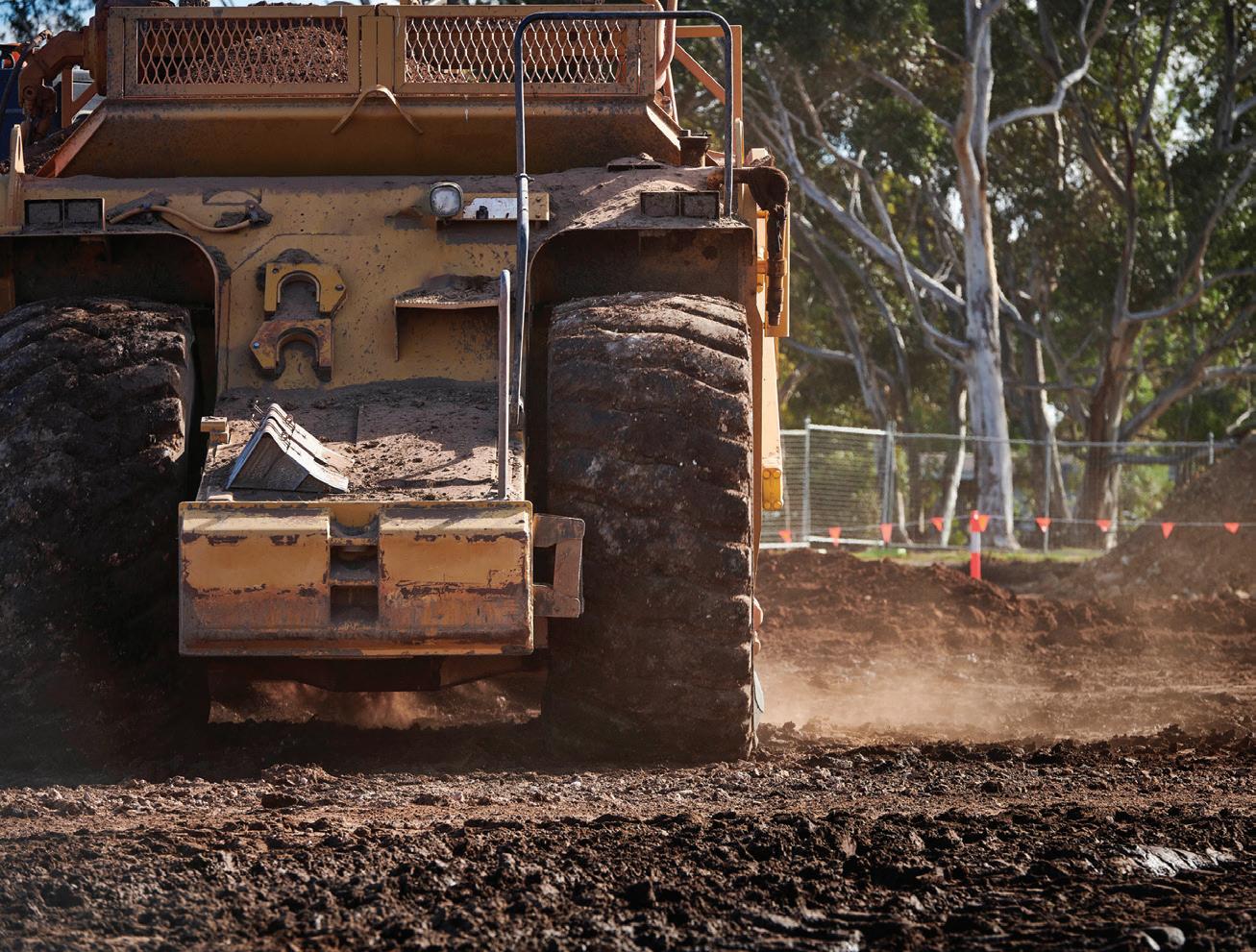

Queensland is in focus this month, featuring a luxury residential development and a transformative highway upgrade.
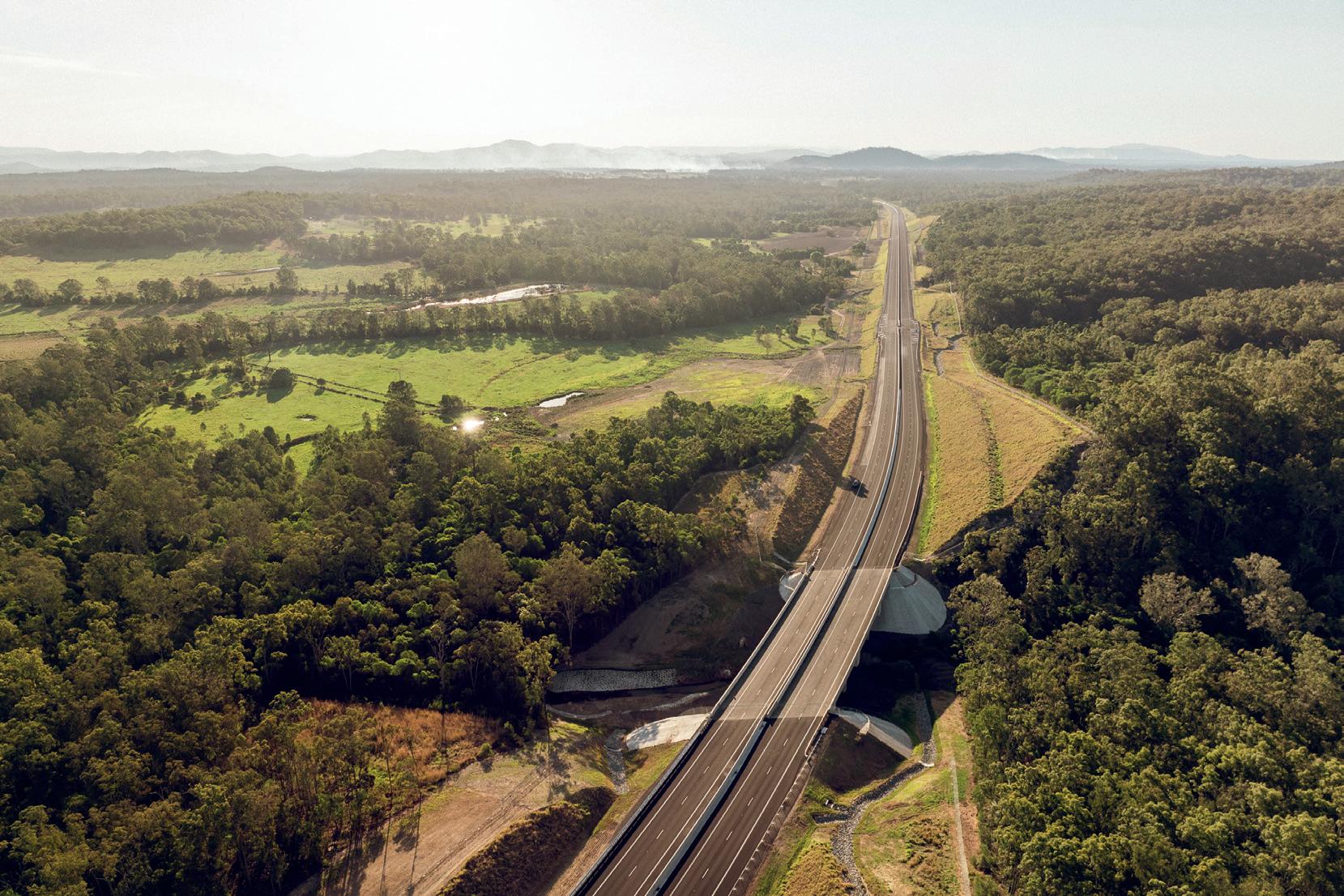
Bruce Highway Upgrade (Cooroy to Curra) Section D2 (Gympie Bypass), Queensland
Contractor: CPB Contractors
Current value: $380 million
Details: The Bruce Highway Upgrade – Cooroy to Curra Section D2 (Gympie Bypass) project, located between Woondum and Curra, was delivered by CPB Contractors for Queensland’s Department of Transport and Main Roads in October 2024. The project included the construction of 18 kilometres of new highway, 19 bridges and a new interchange at Curra, as well as realignments of local roads.
Status: Completed in October 2024.
Initiatives: Local employment, skills development, Indigenous engagement and sustainability all benefited from the project. Outcomes included more than 80 per cent local participation, with 2,362 workers inducted and 393 subcontractors and suppliers engaged. A total of $239 million was spent locally, directly benefiting Gympie and its broader communities. There was also formal recognition of, and ongoing connection to, the Kabi Kabi Traditional Owners. The project exceeded CPB Contractors’ Stretch Reconciliation Action Plan target of 4 per cent by achieving 5.7 per cent First Nations employee representation. Additionally, seven Indigenous businesses were engaged with more than $8.7 million spent. A total of 50 trainees and apprentices were engaged, and 176,000 training hours were delivered, including almost 100,000 for new entrants to the construction industry. The project also provided flood clean-up assistance in Gympie following severe and historic floods in 2022. The project upheld industry best practices across health, safety, environment and quality, including more than two million hours worked lost time injury free; the removal of 82,000 truck movements during construction due to the installation of a 6km pipeline providing a reliable construction water supply; and the planning, design and construction of 106 erosion and sediment control basins to manage all stages of construction, from clearing and bulk earthworks to final pavement works.
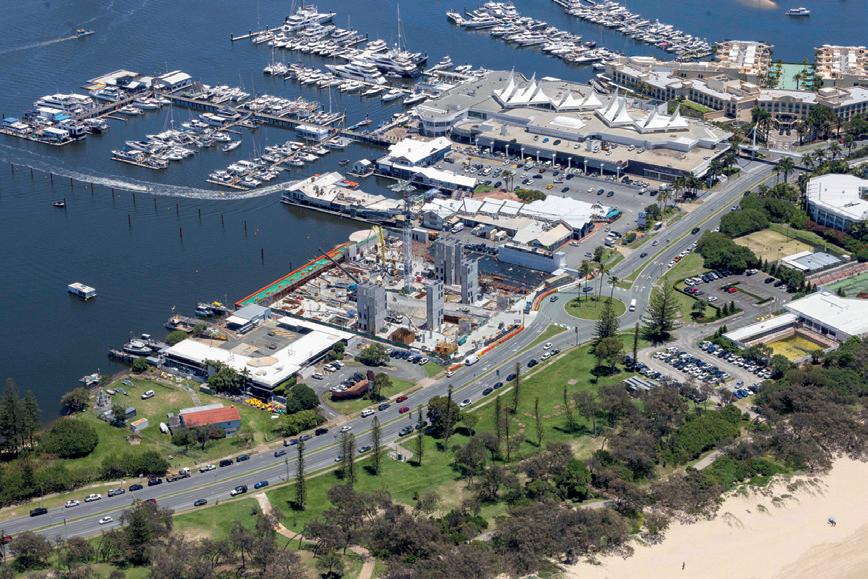
Contractor: Laing O’Rourke
Current value: Approximately $82.5 million
Details: In February 2023, Laing O’Rourke was awarded the contract by Transport for NSW to deliver a new footbridge and pedestrian plaza at St Marys Station as part of the Sydney Metro – Western Sydney Airport project. The footbridge will enable commuters to transfer between the new metro platforms and suburban trains on the T1 Western Line. It will also link to a new pedestrian plaza at the northern end of the footbridge, providing access to the existing station and improving connectivity in St Marys. The space will feature green areas, kiss-and-ride facilities, bicycle storage, and provide potential for future development. The design prioritises safety, durability and aesthetic appeal, complementing the surrounding urban environment.
Status: The project is currently in the construction phase. Recent onsite activities have included excavation, concrete works and steel reinforcement. Progress is tracking well, with the team focused on achieving key milestones, including completion of foundations and precast pier walls, with works coming out of the ground in the coming months.
Initiatives: The project team collaborated with subcontractor AnewX to trial the use of hydrotreated vegetable oil (HVO) in plant and equipment. Positive results have been reported, with consistent engine performance and seamless transitions between fuel types. Derived from vegetable oils and waste-based feedstock, HVO reduces greenhouse gas emissions compared to fossil diesel.
Contractor: Multiplex
Current value: $160 million
Details: The Mantaray by Gordon Corp is situated on the foreshores of the Gold Coast’s iconic Broadwater. Located on The Spit’s Seaworld Drive, the residential development will be home to 24 luxury two-, three- and four-bedroom apartments and villas, along with a 67-berth superyacht marina.
Status: Construction is underway, with all eight stair and lift cores installed using precast concrete. This method has allowed suspended slabs to progress uninterrupted while the remaining basement raft construction is completed.
Initiatives: An activated retail plaza

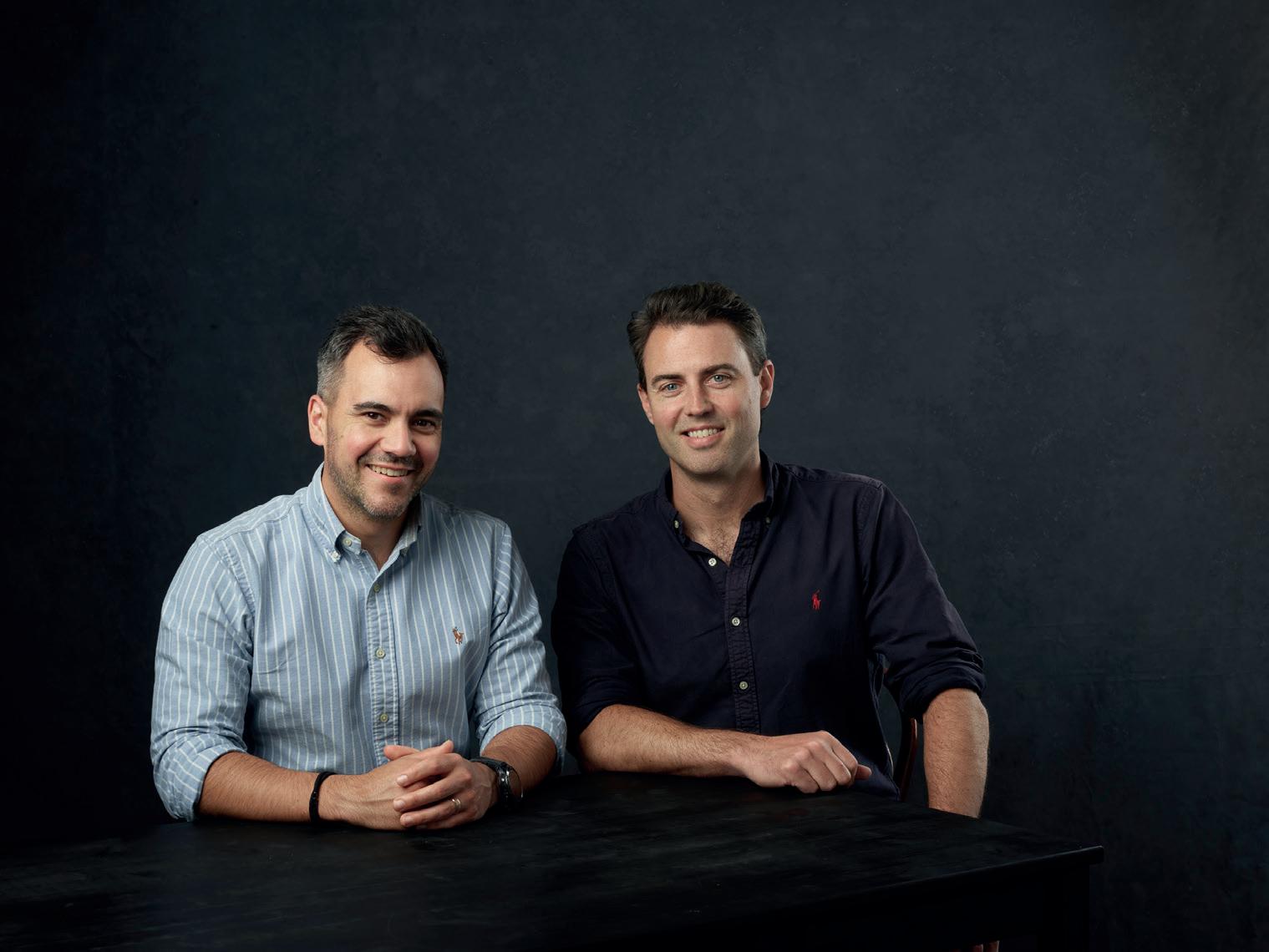
Visibuild isn’t just following the blueprint – with a clear vision, expertise and a strategic edge – it’s carving out a new approach to construction quality management.
“We need to build quality into the process from the start.”
In the construction industry, quality control has often been relegated to an afterthought – a task to tick off the list once a project is nearing completion. But what if quality wasn’t just something to inspect at the end? What if it was the foundation of every decision, every task and every project from day one?
This is the shift championed by Visibuild, a quality assurance platform developed by members of the Australian construction industry. Visibuild is on a mission to challenge the status quo and position quality as the cornerstone of every construction project.
Quality as a culture, not a checklist
In an environment where speed, efficiency and productivity have long been prioritised, quality control has often been viewed as
a cumbersome add-on. It’s easy to see why. In the race to meet deadlines, quality checks were frequently sidelined, treated as secondary to the pressing demands of construction schedules.
For Visibuild director Ryan Treweek, who has spent 17 years in the industry, this mindset was never the answer.
“Quality has always been left in the background,” says Treweek. “Being overlooked for so long, it requires a real cultural shift to move people away from the mindset of treating it as an afterthought.”
The tide, however, is turning. As buildings grow more complex and regulatory demands increase, the push for better quality has become inevitable. Changing an industry steeped in tradition is no small task, but

Visibuild’s leadership has embraced the challenge. United by a collective vision to make “quality the foundation of construction,” the company aims to drive cultural change through innovation.
Visibuild is using technology to not only digitise existing systems, but to transform how construction projects are built and how quality is managed.
“Technology has advanced significantly in the past decade, and the industry is starting to recognise that compliance and quality can no longer be checked off post construction,” says Treweek. “We need to build quality into the process from the start.”
Fellow company director Damien Quinn emphasises that technology alone cannot solve the problem.
“Unless you understand the underlying drivers of how projects are built and the motivations of the people involved, you’ll never be able to change the culture and mindset needed to implement quality control effectively,” he says. “Without this shift, attempts to integrate technology into quality control will be counterproductive.”
Visibuild’s software is designed with this cultural shift in mind. It moves quality from a passive, reactive process to an active, real-time one. By embedding quality checks throughout
“It’s no longer just about compliance – it’s about unlocking efficiency across the entire project lifecycle.”
Visibuild connects quality control to real‑time project progress.
(Image: Ned Meldrum)




“Being overlooked for so long, it requires a real cultural shift to move people away from the mindset of treating it as an afterthought.”
the project lifecycle, Visibuild aims to reduce errors, prevent costly rework and set a new standard for the industry.
From vision to execution
The COVID-19 pandemic served as a turning point. It gave the founding team the time to assess their careers and confront the frustrations they had experienced. They realised that addressing construction’s biggest challenges required a new approach in how projects were managed, rooted in quality.
Founded in 2022 by Quinn, Renee and Shaun Phelan, and Dave Allie – with Treweek leaving an executive post to join the team in 2023 – Visibuild has rapidly gained traction. But introducing cultural and technological change to a staunch industry has been no easy feat.
The basis for Visibuild stemmed from the team’s combined experiences in construction. After working more than a decade for the same contractor, they encountered recurring issues: rushed jobs, costly mistakes, and a quality control system that lacked the data and insights to enable meaningful change.
“Lessons learned” discussions were common, but past mistakes were often repeated as new projects began without time for reflection. Treweek likens this cycle to a hamster wheel – a constant race with little opportunity to improve processes.
“We knew that just introducing a piece of software wasn’t enough,” says Treweek. “We had to change the culture. You can’t just push a new tool onto a team without changing how they think about the process.”
Turning data into decisions
Visibuild’s strength lies in how it connects quality control to real-time project progress. The software doesn’t merely track errors; it identifies them as they occur, enabling immediate corrective action and preventing issues from mounting, which can ultimately delay projects or cause legacy quality issues.
“Historically, measuring quality control or compliance was almost impossible,” says Quinn. “Audits were infrequent, covering only a small fraction of projects. That left a huge gap in visibility and a lot of room for errors.”
Visibuild has turned this on its head by offering real-time visibility into quality control,
systems compliance and project outcomes. Its database categorises quality control data in granular detail – whether related to concrete, finishes or safety features – allowing for deeper insights and better decision-making.
The value of this data extends beyond individual projects. By feeding insights back into the system, Visibuild helps prevent recurring problems and drives continuous improvement. Treweek highlights the importance of using data not just to document issues but to create measurable impact.
“People often accept error as something that just happens, part of the chaos of constructing a building,” he says. “But in reality, if everyone followed the old adage, ‘measure twice, cut once,’ there would be fewer errors and delays.”
One project team in Melbourne experienced this firsthand. Whilst constructing a loading platform suspended several stories in the air, a team member was preparing to unload 200 cubic metres of concrete onto a temporary slab. When checking the mix details through Visibuild, he discovered the wrong mix had been sent and prevented the error by sending the trucks back.
“That moment completely changed his outlook,” says Quinn. “He went from being a sceptic to a firm believer in the system. This is the mindset shift we’re trying to create in the industry.”
Building relationships, not just software Visibuild’s success is also underpinned by its commitment to relationship-building. In an industry driven by trust, maintaining integrity has been central to its approach.
“Having spent years in the industry, we’ve worked hard to build a reputation for integrity across Australia,” says Treweek. “Maintaining that trust is essential to us.”
Visibuild involves customers in the platform’s development journey, regardless of their business size. Quinn believes that collaboration and authenticity are key to fostering trust and aligning with clients’ needs.
“It’s about bringing people along on the journey and showing them how their input aligns with a bigger, more meaningful goal,” he says. “That sense of alignment and shared purpose is critical for balancing day-to-day execution with our larger goals.”

Driving the shift
Visibuild’s goal is to raise the baseline for quality and compliance across the construction industry. By positioning its platform as the “central nervous system” for construction data, it is helping businesses harness information to drive efficiency and transparency.
“When people realise the value of knowing, with certainty, that tasks have been done properly, it transforms their understanding of quality assurance,” says Treweek. “It’s no longer just about compliance – it’s about unlocking efficiency across the entire project lifecycle.”
In a rapidly changing world, where regulatory shifts, sustainability concerns and digital transformation are reshaping industries, Visibuild is prepared. Its approach may have
started with a singular focus on quality, but it has grown into something much greater: a movement to embed process into every decision, action and project.
Both Quinn and Treweek are optimistic about Visibuild’s potential to raise quality assurance standards globally.
“With an extensive development pipeline of new features and modules underway, we will continue driving cultural change in the construction industry through our innovative approach to quality management,” says Quinn.
Visibuild is redefining how quality is perceived and practised in construction. By combining technological innovation with a focus on cultural transformation, it is creating a new paradigm where quality becomes an intrinsic part of the industry.
“Technology has
advanced significantly in the past decade,
and
the industry is starting to recognise that compliance and quality can no longer be checked off post construction.”
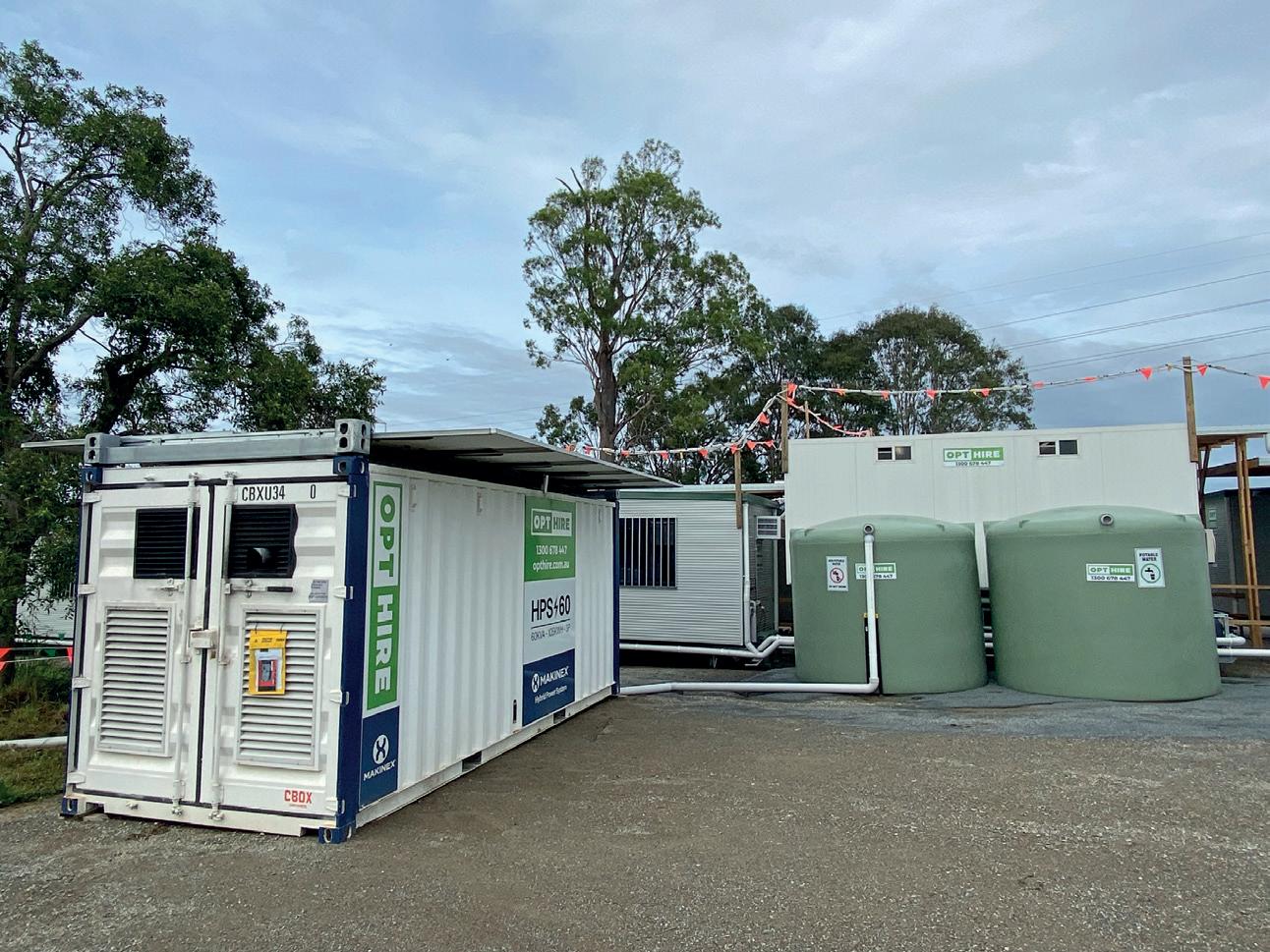
A hybrid generator powered by biodiesel and solar, paired with stormwater harvesting from site sheds for toilet use. (Images: Winslow)
Sustainability is part of Winslow’s DNA –through a blend of innovation, collaboration and long-standing values, it has always been more than compliance.
For Winslow, sustainability isn’t just a box to tick – it’s a responsibility to embrace.
While the civil construction company has championed sustainable practices for years, it hasn’t always been vocal about its efforts.
Dean Lal, Winslow’s group environment and sustainability manager, says the company’s focus has always been on delivering results, not seeking recognition.
“We’ve realised that sharing what we’ve learned can drive broader change across the industry. It’s not about saying, ‘look at us.’ It’s about fostering collaboration and empowering others to join the journey,” says Lal.
Winslow recently raised the bar by securing an IS v2.1 Ecology credit (Eco-1) for the Sunbury Road and Lathams Road Upgrades under the Infrastructure Sustainability Council’s (ISC) rating scheme. The IS Rating Scheme evaluates economic, social and environmental performance across all phases of infrastructure projects.
“This was our first time pursuing these ratings, and we secured three excellent outcomes. It’s a testament to the expertise and collaboration across our teams and with Major Road Projects Victoria (MRPV),” says Lal.
“We’ve realised that sharing what we’ve learned can drive broader change across the industry.”
With more than 25 years of environmental sustainability expertise, Lal understands the power of collective action. Winslow’s projects are designed with sustainability in mind, but the company is now stepping up to forge deeper partnerships with government and private clients to amplify its influence.
“Our sustainability strategy doesn’t just align with government requirements – it exceeds them,” says Lal. “We’re driving innovation on major infrastructure works, setting new standards, and helping lead the industry forward.”
“While Tier 1 contractors have been working in this space for years, we’ve proven that we are now on par with these industry leaders, a fact that has been acknowledged by MRPV.”
Tackling challenges like brownfields environments and rigorous compliance head-on, Winslow’s efforts didn’t just meet expectations – they exceeded them. Tools like SoilFlo, which tracks soil movements, enabled high spoil reuse rates while hitting environmental benchmarks. Meanwhile, Aqua Prep, a hydro-demolition method using 100 per cent recycled non-potable water, reduced
reliance on potable water and eliminated the need to transport contaminated water offsite, minimising environmental and logistical impacts. These initiatives align with ecologiQ, a Victorian Government program that promotes the use of recycled materials and a circular economy approach in transport infrastructure projects.
Another game-changer, the Guard Dog Drain Filter, safeguarded waterways by trapping sediment at stormwater grates, outperforming traditional solutions like silt logs.
“This approach is more reliable, sustainable and lasts up to six months with minimal maintenance,” says Lal.
While these tools have delivered impressive results, Lal highlights that collaboration with clients and stakeholders is the cornerstone of success when it comes to sustainability.
“Engaging with clients early in the process is crucial. We cannot achieve these outcomes alone; everyone involved needs to be aligned,” he says. “Innovation during the design phase opens up far more opportunities to implement sustainable solutions. Waiting until the delivery phase makes meaningful changes much harder to achieve.”
Lal notes that Winslow’s use of SoilFlo, Aqua Prep and the Guard Dog Drain Filter on the Sunbury and Lathams Road Upgrades marked their first application in Australia – a testament to the company’s proactive approach to innovation.
Building a culture of leadership
Winslow’s sustainability efforts are powered by its core values – Family, Accountability, Commitment, Empowerment and Safety (FACES). Empowerment, in particular, plays a crucial role in enabling every team member to take ownership of sustainability initiatives.
“This isn’t just about leadership at the top,” says Lal. “From the CEO to construction crews, everyone is driving change. Our CEO’s unwavering commitment to sustainability has united the entire organisation behind this vision.”
This leadership and teamwork were recognised when Winslow’s Sunbury Road Upgrade team won the 2024 Civil Contractors Federation (CCF) Earth Award for the best project over $150 million, further
solidifying the company’s commitment to environmental excellence.
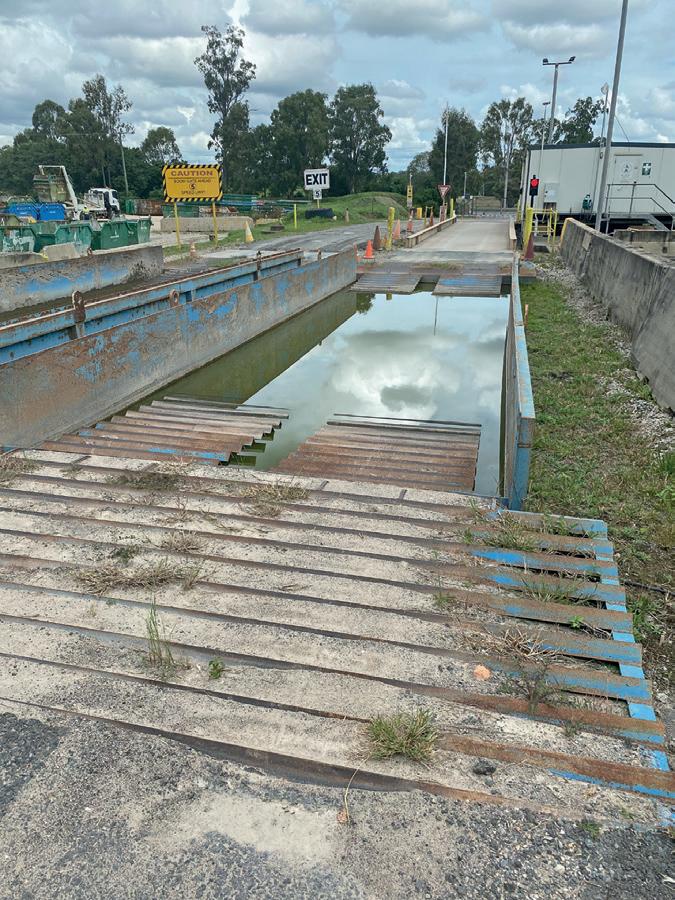
Also in 2024, the Winslow Environment and Sustainability Team was awarded the CCF Industry Award for Sustainability Excellence.
The team was recognised for exemplifying excellence in initiative, capability and subject matter expertise, demonstrating a commitment to learning, supporting delivery teams and advancing broader sustainability initiatives across Winslow.
“Collectively, the team has shown immense capability in leading cultural change within Winslow while transforming the planning, design and delivery processes and practices across both MRPV and other projects,” says Lal.
“These awards underscore what can be achieved when you equip your team with the right resources, empower them to innovate and provide clear direction. It’s all about enabling individuals to excel and contribute meaningfully. Our success stems from our people.”
With new legislation requiring sustainability reporting from 2025, Winslow is ahead of the curve, with sustainability already embedded
“Our sustainability strategy doesn’t just align with government requirements –it exceeds them.”
“Our success stems from our people.”

identifying associated risks, as well as financial

accounting. Reporting will begin with Scope 1
year. By the fourth and fifth years, Scope 3 reporting will expand and require external verification by auditors.
“Given that Scope 3 emissions involve activities related to assets not owned or controlled by Winslow, collaboration with stakeholders is critical,” says Lal. “Many stakeholders are already engaged due to their experience in this area, but others will need to adapt. This will be a highly collaborative process, and those who fail to keep up risk being left behind.”
Winslow is also laser-focused on setting long-term goals, especially around emissions reduction. “Right now, our priority is gathering baseline data. Once we have that data, we can establish realistic, achievable goals,” says Lal.
“We aim to set incremental targets that allow for steady progress and acceleration over time, rather than committing to unrealistic aspirations.”
From groundbreaking innovations like SoilFlo and Aqua Prep to earning top-tier ratings, Winslow is not only addressing industry challenges but also demonstrating what it means to build responsibly for the future.
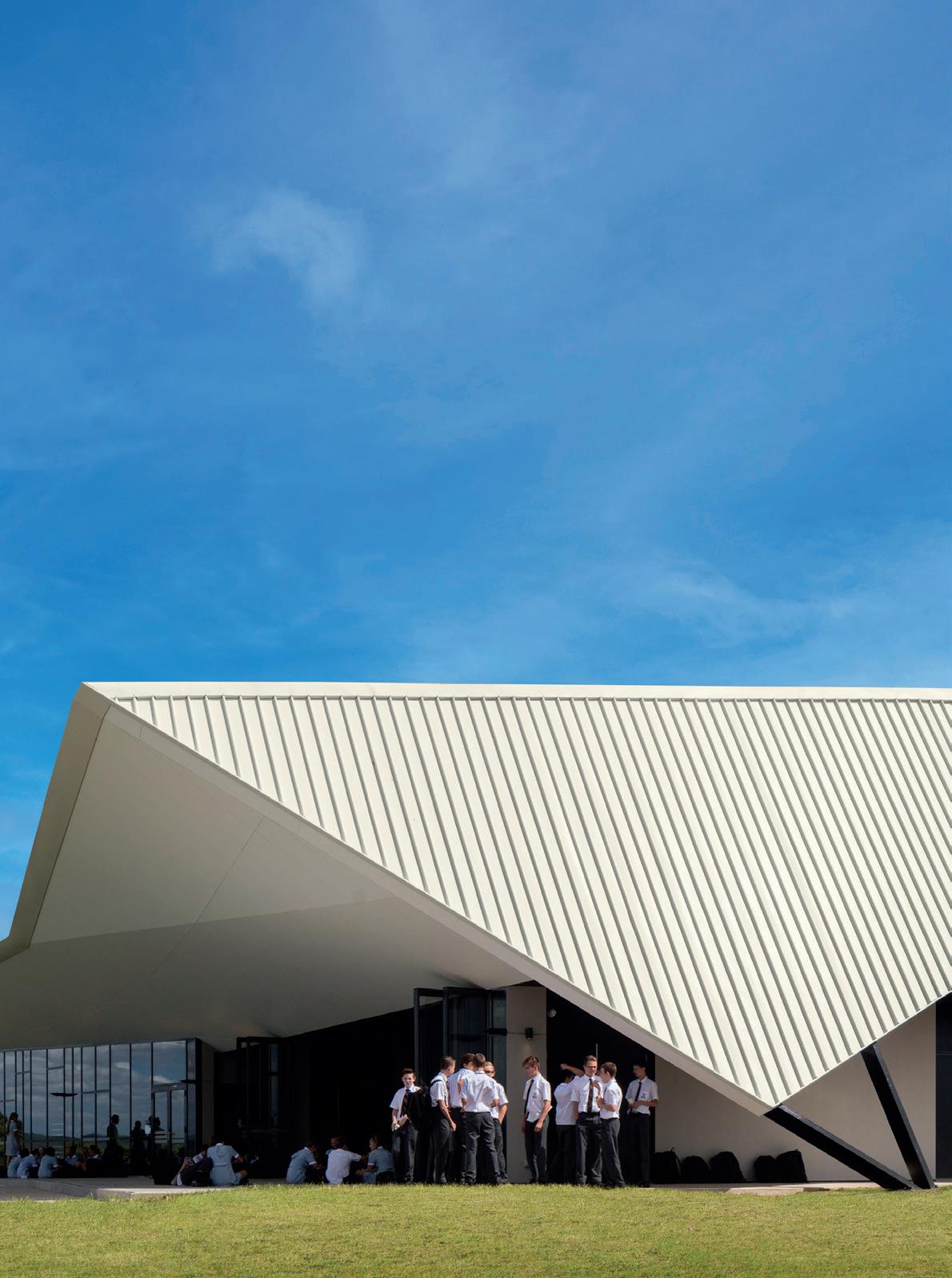
On the 4th of January 2020, Penrith in Sydney’s West was the hottest place on earth, with an extreme high of 52 degrees.
Terroir architects specified COLORBOND® steel Surfmist® in a Classic finish for the expansive, visually striking roof on the Penrith Anglican College Performing Arts Centre, knowing the choice of a lighter colour would lower solar absorption and in turn lower the buildings ongoing HVAC costs. Not only can the roof help toward creating a cooler environment for its students by lowering heat absorption, but also by creating a positive impact on the surrounding community environment by helping to reduce the effects of Urban Heat Islands.
With 11 COLORBOND® steel cool roofing colours featuring low Solar Absorptance values of less than or equal to 0.45*, architects and specifiers now have a wide colour choice that achieves deemed-to-satisfy compliance within the National Construction Code (NCC) Section J energy efficiency provisions.
To find out more about COLORBOND® steel’s cool roofing colours, visit steelselect.com.au/coolroofing

Viva Energy is helping the construction sector make strides toward sustainability by showcasing the practicality and environmental benefits of renewable diesel.
The construction industry is at a critical juncture: balancing the demands of productivity with the need for sustainability. Diesel-powered equipment has long been the backbone of the sector, but with the growing demand for cleaner solutions, renewable diesel – also known as hydrotreated vegetable oil (HVO) – presents a promising alternative.
Australian energy company Viva Energy is making renewable diesel more accessible, enabling construction companies to reduce their carbon footprint and take a decisive step toward decarbonisation. Produced from renewable feedstocks like used cooking oils and animal fats, renewable diesel offers a reduction in carbon emissions compared to conventional diesel.
Robert Cavicchiolo, carbon solutions manager at Viva Energy, describes it as a “game-changer” for the construction industry.
“Renewable diesel offers the comparable performance as conventional diesel but with lower emissions,” says Cavicchiolo. “It’s a straightforward, drop-in solution that allows companies to continue operations while reducing their carbon footprint.”
The key advantage of renewable diesel is its seamless compatibility with existing diesel infrastructure. Its hydrocarbon structure is very similar to fossil fuel diesel, meaning construction companies can use it in their current machinery, fleets and generators without any costly modifications.
Produced using a hydrotreating process, renewable diesel turns feedstocks such as used cooking oils and animal fats (tallow) into a high-quality fuel. Not only does it reduce carbon emissions, but it also has the potential
to reduce particulate matter, nitrogen oxides (NOx) and carbon monoxide, improving air quality on construction sites and in surrounding communities.
“Renewable diesel can reduce emissions by 70 to 90 per cent compared to traditional diesel, based on a life cycle analysis basis, helping companies achieve their emission reduction targets,” says Cavicchiolo.
Seamless transition, immediate benefits
Switching to renewable diesel is straightforward. Companies don’t need to upgrade equipment or change infrastructure – simply switch the fuel supply. Equipment manufacturers, including Liebherr, Volvo, Kubota, JCB, MTU, John Deere, Cummins and Caterpillar now support renewable diesel in their service bulletins and fuel recommendations, providing businesses with the confidence that it won’t disrupt operations. It is always recommended to check with the equipment manufacturers before switching to renewable diesel.
Viva Energy also ensures a reliable supply of renewable diesel, sourcing fuel from certified sustainable feedstocks under the International Sustainability & Carbon Certification (ISCC) standard.
This certification guarantees the fuel meets environmental and ethical standards.
Renewable diesel’s compatibility with existing storage and refuelling infrastructure and its ability to reduce emissions make it a practical solution for companies looking to transition to greener operations.
considerations
While renewable diesel offers clear benefits, there are some factors companies should consider before making the switch:
1. Supply – renewable diesel, similar to conventional diesel, is currently imported into Australia and hence requires planning if companies want to convert over to its use. However, Viva Energy ensures consistent availability through a robust supply chain.
2. Cost – renewable diesel typically comes at a premium compared to traditional diesel. Despite this, the long-term environmental and regulatory benefits may justify the additional cost.
3. Transition – the transition to renewable diesel is simple and doesn’t require significant downtime or equipment upgrades, though companies should complement its use with their existing fuel

“It’s a straightforward, drop-in solution that allows companies to continue operations while reducing their carbon footprint.”
“For some off-road applications, where electrification or green hydrogen isn’t yet viable, renewable diesel provides an attractive interim solution.”

As the construction industry faces increasing pressure to reduce its environmental impact, renewable diesel offers a viable, drop-in solution. It helps companies stay ahead of regulatory requirements and lower emissions – all while continuing to rely on the machinery and vehicles they’ve already invested in.
Hydrocarbon Solutions team, we can help customers establish or upgrade fuel farms, project-manage tank installations and ensure reliable, on-spec supply.”

“We’re
here to guide construction companies through the switch to renewable diesel.”
“Renewable diesel is recognised under Australian Government legislation, such as the National Greenhouse and Energy Reporting (NGER) Scheme and National Greenhouse Accounts Factors (NGAF), for those facilities who are listed under the safeguard mechanism,” says Cavicchiolo.
“For some off-road applications, where electrification or green hydrogen isn’t yet viable, renewable diesel provides an attractive interim solution.”
Viva Energy isn’t just a supplier of renewable diesel; it’s a partner in the journey toward sustainability. From educational resources to technical support, the company is committed to helping businesses transition with minimal disruption and confidence.
“We’re here to guide construction companies through the switch to renewable diesel,” says Cavicchiolo. “Through our
The company’s Carbon Solutions and New Energies teams provide expertise in decarbonisation and collaborate with emerging technologies to explore future opportunities. As a technology-agnostic partner, Viva Energy stays forward-looking and adaptable, helping construction companies achieve sustainability goals while keeping pace with industry trends.
The construction sector is adopting renewable diesel as a transitional solution on the road to zero-emission technologies. Supported by a reliable supply chain and technical expertise, companies can confidently make the switch to a more sustainable future.
“Globally, renewable diesel has been in use for years in regions like Europe and the United States, and Australia is now following suit,” says Cavicchiolo. “With a well-established import model and a national supply footprint, we can serve customers across Australia.” By championing renewable diesel, Viva Energy empowers companies to make informed decisions that align with their sustainability goals, reduce emissions and maintain peak performance.

Topcon MC-Mobile

3-in-1 solution for excavators and compact track loaders
Excavators from $55K + GST installed
CTLs from $60K + GST installed
Measure, design and build with a single system! Powered by Topcon Pocket3D software, MC-Mobile is a versatile machine control and survey rover solution in one.
• Compatible with Tokara remote suppoprt
• Works with a wide range of attachments and accessories
• Hardwire and hire options available
Terms and Conditions apply, visit www.aptella.com for full details. Warranty for serialised components only Available now with


Situated in the social hub of South Brisbane, Upper House is a 5 Star Green Star rated multi‑residential tower that is inviting a new way of inhabiting cities.

From its dramatic architecture, inspired by the Moreton Bay fig tree, to its dancing balconies, Upper House embodies a modern design ethos – harmonising nature, wellbeing and environmental excellence in sustainable vertical living.
Designed by Koichi Takada Architects, the 32-storey building houses 188 apartments and features a five-storey artwork by Australian artist Judy Watson. Titled Bloodlines weaving string and water, 2023, the perforated metal, folded and backlit piece offers a cultural narrative, acknowledging the Turrbal people as the traditional custodians of the land.
With its striking exterior – evoking Moreton Bay fig tree roots framing the building and a canopy curling around the roof – it
celebrates the natural world while treading lightly on it. Davina Rooney, CEO of the Green Building Council of Australia, says the design and sustainable features of the 5 Star Green Star rated residential tower, along with the commitment to deliver homes designed for energy efficiency and resiliency, should be applauded.
“Upper House represents Australian excellence in sustainable design – a vision of sustainable urban living with high-quality apartments designed for efficiency, healthy living and low emissions,” says Rooney.
“They represent a future where apartment living is climate-resilient and comfortable, without sacrificing performance or architectural design.”


Urban high-rise living can sometimes feel disconnected from community and nature – a far cry from the classic suburban lifestyle so often associated with Australia. But according to architect Koichi Takada, this space was designed to bring people together.
“High-rise living can sometimes feel isolating, but we’ve designed spaces to bring people together and foster community,” says Takada.
“For example, on the rooftop, we created inviting amenities where residents can meet, relax and socialise. It’s like a shelter in the sky – a place where you’re encouraged to interact with your neighbours.
“When people love a space, they’ll not only enjoy it today but pass it on to future generations. That’s true sustainability.”

What makes Upper House sustainable For Aria’s development manager, Michael Hurley, pursuing the Green Building Council of Australia’s Green Star certification – Australia’s only national, voluntary, holistic rating system for buildings and communities – was about creating something for which they could be proud of.
“Our guiding principle is to create residential and retail spaces that we’ll be proud to walk past with our families in 20 years,” says Hurley.
“We also want to be proud of the decisions we’ve made during the construction, ensuring they consider our future generations.
“Upper House is fortunate to be developed within Brisbane City Council, which supports well-designed, green and energy-efficient buildings. Its Brisbane Green Building Incentive Policy assisted in offsetting the substantial investment in capital to achieve Green Star.”
The team behind Upper House designed and built with best practice sustainability in mind, focusing on key areas such as water, emissions, energy, transport, land use and ecology, materials, and indoor environment quality.
The building is designed to achieve more than an 11 per cent reduction in potable water consumption compared to a standard build, while a 40-kilolitre rainwater harvesting tank is used for irrigation, collecting an average of 170 kilolitres annually – reducing the demand for irrigation water, particularly during increasing periods of extreme heat.
Upper House was designed and constructed with a focus on reducing greenhouse gas
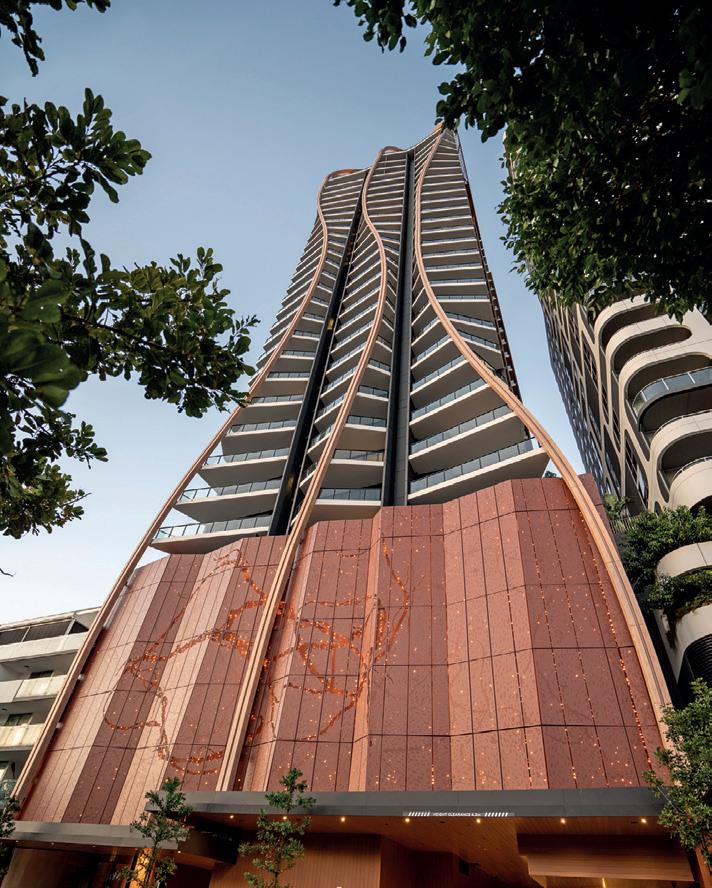
“High-rise living can sometimes feel isolating, but we’ve designed spaces to bring people together and foster community.”

along with 60 electric vehicle charging stations and 194 bicycle parking spaces for tenants. A rooftop designed for living, working and leisure further reduces the need for external travel.
Upper House, once an entirely hardstand site, has been transformed to maximise green space and environmental sustainability, with native plants and indigenous landscaping enhancing its ecological value. The site’s ecological value has increased 100-fold, with landscaping, shading and water elements now covering 75 per cent of the area, helping mitigate the urban heat island effect.
The materials chosen impact the environment at every stage of a building’s lifecycle. For this reason, responsible material selection and waste management are key strategies for reducing carbon emissions and addressing the high percentage of waste generated by construction and demolition, which accounts for 40 per cent of all waste in Australia.
All building materials went through an assessment for environmental impact throughout their lifespan, ensuring sustainability.
“When
people love a space, they’ll not only enjoy it today but pass it on to future generations. That’s true sustainability.”
During construction and demolition, 93.4 per cent of waste was diverted from landfill, with 2,141,882kg recycled. The team conducted monthly waste reporting during construction to ensure the implementation of waste initiatives.
The team behind Upper House worked to reduce CO2 emissions and achieved improvements compared to reference projects. With the aid of solar panels, CO2 emissions dropped by 21 per cent, and fossil fuel consumption decreased by 19 per cent.
The building was also constructed using responsible and sustainable materials, all verified by third-party certifications. Green concrete was used, along with recycled water and aggregate. Fly ash, a by-product of coal
combustion in power stations, served as a binding agent, supplementing 30 per cent of the concrete used in this project.
When it comes to sustainable buildings, the indoor environment quality – including thermal comfort, indoor air quality and indoor pollutants – comes into play.
Harmful pollutants were minimised at Upper House through the selection of low-VOC paints, adhesives, sealants and carpets. This approach reduced volatile organic compound emissions by 95 per cent, improving indoor air quality and occupant wellbeing.
The apartments feature acoustic insulation, including windows, walls, ceilings and floors, minimising both internal and external noise disturbances for the comfort of residents and neighbours.
Along with thermal comfort, the apartments offer energy efficiency, with an average NatHERS (Nationwide House Energy Rating Scheme) rating of 8.4 stars, surpassing best practice standards. The 3-metre-high ceilings and double-glazed glass optimise natural light and reduce the need for air conditioning.
For Hurley, the certification is a result of staying aligned with sustainability goals and not cutting corners – achieved through clear reporting and communication with the team, from subcontractors to consultants. The project also reflects a dedication to pushing boundaries, incorporating organic, living elements rarely seen in high-rise buildings.
“The journey of Upper House, 5 Star Green Star took more than three years of dedication, perseverance, and a substantial investment in capital. When we finally received the 5 Star Green Star Design and As Built rating, it was a huge relief and a moment of immense pride,” says Hurley.
“Furthermore, knowing the residents of Upper House will experience the long-term benefits of the decisions we made as a collective team is incredibly rewarding.”
Green Star certification not only delivers environmental excellence but also creates healthier, more connected and resilient communities. We invite developers, architects and policymakers to follow Upper House’s lead and join us in shaping a sustainable future for urban living. Together, we can create a legacy of buildings that inspire, endure and tread lightly on the planet.



Topcon technology is igniting a surge in productivity for Universal Civil Contracting Brisbane.
Universal Civil Contracting Brisbane has built a strong, enduring partnership with Aptella over the past 15 years, beginning with the purchase of its first Topcon lasers. From the outset, Universal Civil recognised the value of Topcon’s technology, remaining a loyal advocate ever since. This long‑term relationship has been instrumental in supporting the company’s growth and maintaining its position at the forefront of the construction industry.
As a foreman at Universal Civil, Mark Smith oversees a range of large scale construction projects across Brisbane and the Gold Coast, including new schools, shopping centres and logistics facilities, such as the Australia Post distribution centre at Brisbane Airport.
Smith explains that to ensure smooth operations and deliver the best outcomes, Universal Civil relies on top t ier technology, including Topcon’s machine control systems.
As technology has advanced, Universal Civil has embraced Topcon’s machine control solutions to enhance the precision

and efficiency of its operations. The company initially adopted the MCR3 system, followed by the MC I platform, and is now utilising the MC Max system across its fleet of graders, dozers, excavators and other heavy machinery. The integration of these machine control systems has improved the accuracy of grading, excavation and earthworks on complex projects, ensuring positive results with minimal rework.
“At Universal Civil, we use the Topcon MC Max platform across a variety of our equipment, including excavators, graders, compactors and scrapers,” says Smith.
“The MC Max system offers exceptional accuracy and control, allowing us to achieve precise grading, excavation, and earthworks with minimal rework. This is particularly important on large, complex sites like the Australia Post distribution centre, where every centimetre counts.”
In addition to the MC Max system, Universal Civil relies on a suite of Topcon products and software to support its operations. The Topcon HiPer VR receiver

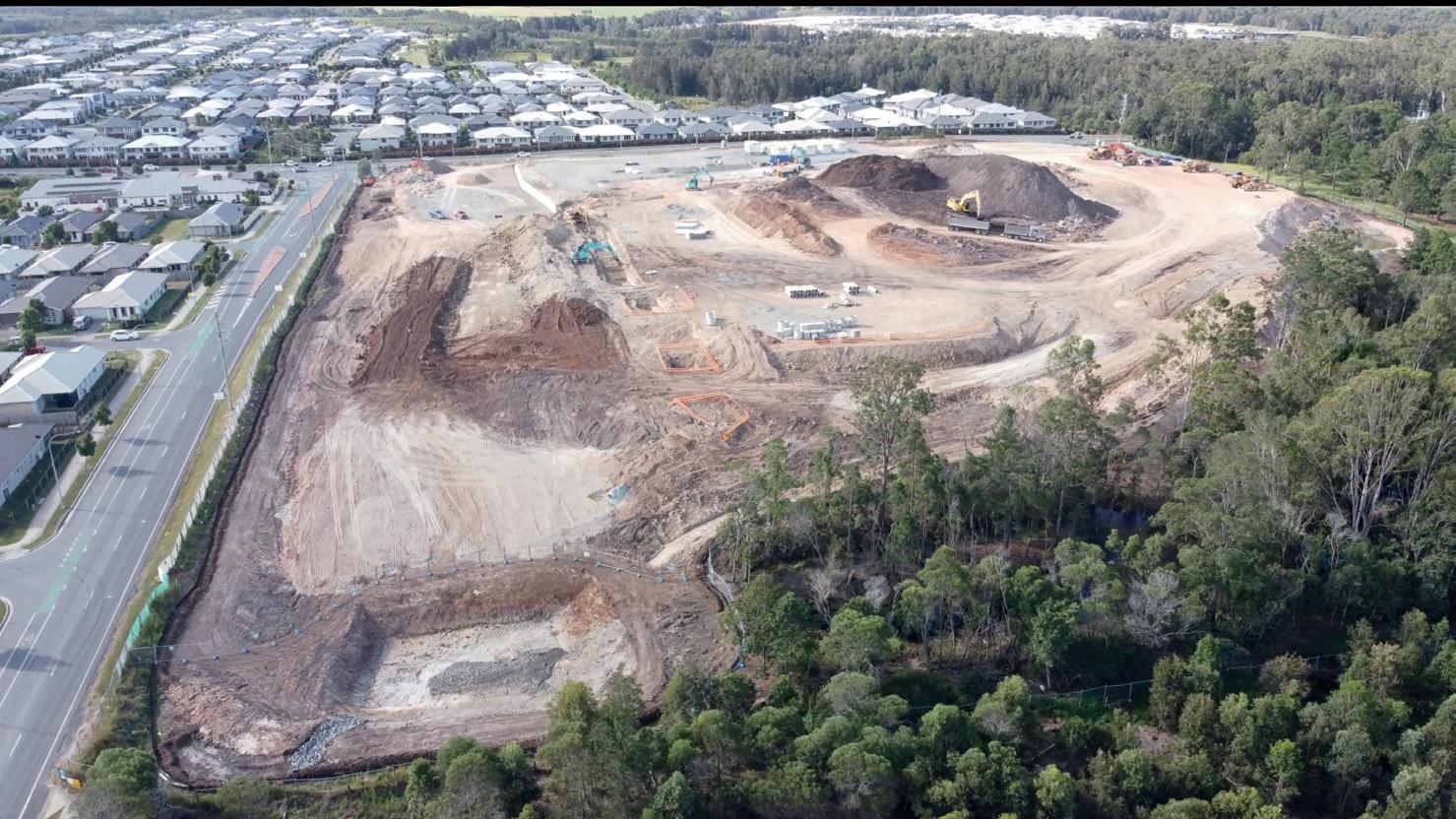
and Pocket 3D software play a key role in enhancing site positioning and providing real t ime data, further streamlining the company’s workflows and increasing overall productivity. Together, these technologies ensure that Universal Civil’s projects – ranging from large infrastructure developments to logistics facilities – are completed with high precision and efficiency.
Smith highlights that the support from Aptella has been invaluable, noting that the team not only supplies the best in Topcon technology but also offers exceptional after‑sales service: “Aptella’s technical team truly sets them apart.”
“They’re always just a phone call away, and whenever we encounter an issue – though they’re rare – it’s always minor and quickly resolved,” he says.
“Their deep knowledge of Topcon’s systems ensures we receive expert advice and real‑time assistance whenever needed. This integration of Aptella’s support with Topcon’s advanced positioning technology gives us the confidence to operate with complete reliability and efficiency.”
Smith says Topcon’s machine control technology, combined with Aptella’s service, is second to none. He highlights the systems’ ease of use, reliability and robustness as factors that have enhanced Universal Civil’s
“Aptella’s technical team truly sets them apart.”
The Topcon MC-Max system improves the accuracy of grading, excavation, and earthworks operations.

workflow. With Aptella’s support, Universal Civil is able to minimise downtime and maximise the productivity of its machinery, ensuring superior outcomes on every project.
Smith strongly recommends Aptella to anyone in the construction industry, emphasising that its products and support
“The MC-Max system offers exceptional accuracy and control, allowing us to achieve precise grading, excavation, and earthworks with minimal rework.”
have been crucial to the success and efficiency of Universal Civil’s projects. Thanks to systems like the MC Max platform and Aptella’s support, Universal Civil consistently maximises productivity and achieves positive results, no matter the scale or complexity of the project.


Universal Civil Contracting Brisbane deploys the Topcon MC-Max platform across its fleet of excavators to enhance operational efficiency.


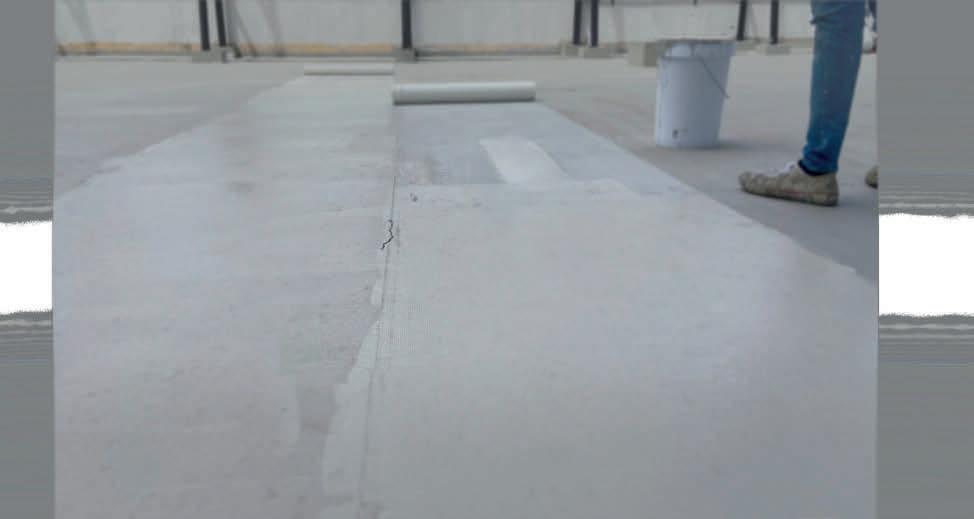


Hobson Engineering, an Australian supplier of fasteners and XCHEM adhesive anchoring systems, is underscoring the importance of European Technical Assessment approvals in construction.
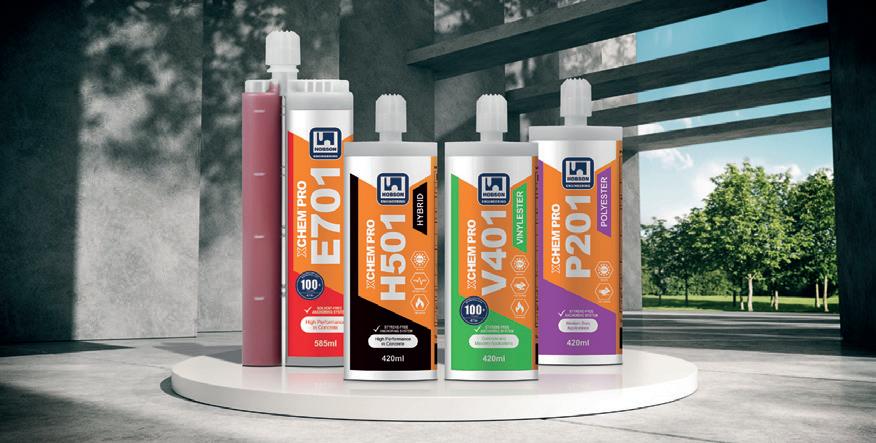
“Our
product range has approvals to ensure performance and suitability for applications ranging from small-scale home projects to large infrastructure developments.”
In Australian construction, the demand for high-quality anchor products with the right certifications has become central to industry practice. At the forefront of this is the European Technical Assessment (ETA) – a certification evaluating construction products for performance and suitability in specific applications.
Gavin McPherson, lead engineer at Hobson Engineering, emphasises the need for construction professionals to understand ETA approvals and their implications.
“ETAs provide a consistent framework for evaluating products across various categories and suppliers,” says McPherson. “This standardised approach simplifies comparisons between products.”
Why ETA approvals matter ETAs ensure products, such as chemical anchoring systems, meet European Union requirements. In Australia, AS 5216 governs the design of post-installed and cast-in fastenings in concrete and is referenced in the National Construction Code (NCC). ETA-approved products are considered compliant with this standard.
“In our market, suppliers have two options: undertake the full suite of testing on a product or use a product with an existing ETA,” says McPherson.
“Most opt for the latter, as testing is rigorous and time-consuming.”
He notes one common misconception: the more ETA approvals a product has, the more a design is perceived to have.
“We often encounter situations where customers ask for additional approvals that are not considered in the design. This would, in effect, result in the end user paying more for a product they did not fully utilise,” he says.
“Extra approvals, like those for seismic or cracked concrete applications, require a reduction in the anchor’s characteristic load capacity. Assuming a higher rating equates to better performance can lead to suboptimal choices. Not considering load reductions for a required design case could result in the failure of the anchor.
“For example, many engineers assume seismic-approved anchors are required for their project without assessing actual risk factors. If the concrete substrate in the anchor location isn’t anticipated to crack during a seismic event, or if the importance or seismic class of the building is low enough, the highest seismic rating may be unnecessary. Careful risk assessment and an understanding of the concrete design are essential to selecting the right anchor for the job.”
The XCHEM range
Hobson Engineering’s XCHEM range of adhesive anchoring systems exemplifies how ETA approvals can help address diverse construction needs:
• XCHEM P201 Polyester – approved for non-cracked concrete, it is suitable for lighter loads in general-purpose and light-duty applications.
• XCHEM V401 Vinylester – approved for cracked and non-cracked concrete, masonry and reinforcing steel applications, with added fire ratings, making it a versatile choice for general-purpose engineered designs.
• XCHEM H501 Hybrid – features approvals for cracked and non-cracked concrete, masonry, seismic categories C1 and C2, and fire ratings. Its high load capacity and fast curing times make it suitable for urban projects.
• XCHEM E701 Pure Epoxy – offering all the approvals of the hybrid product, with the addition of a 100-year design life, it is designed for major infrastructure projects and warmer climates where a longer working time is required to set the anchor.
“Our product range has approvals to ensure performance and suitability for applications
ranging from small-scale home projects to large infrastructure developments,” says McPherson.
Software
Design to AS 5216 is complicated, which is why most suppliers have anchor design software. This software automates the design of chemical anchorages, offering precise results for any application. Chemical anchoring systems require meticulous attention to detail to ensure long-term safety and stability. Design software takes into account all necessary safety factors and provides designs with robust, reliable performance for even the most demanding structural applications.
Towards a deeper understanding
The adoption of ETAs in Australia is still in its early stages, with many engineers yet to fully grasp their implications.
“Careful risk assessment and an understanding of the concrete design are essential to selecting the right anchor for the job.”
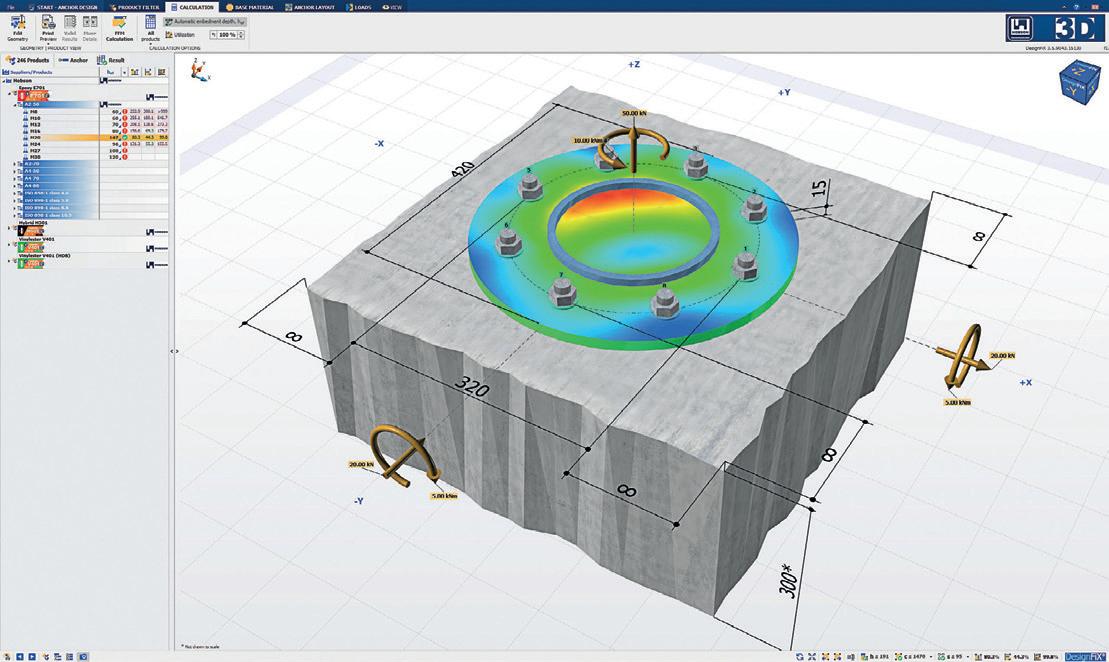
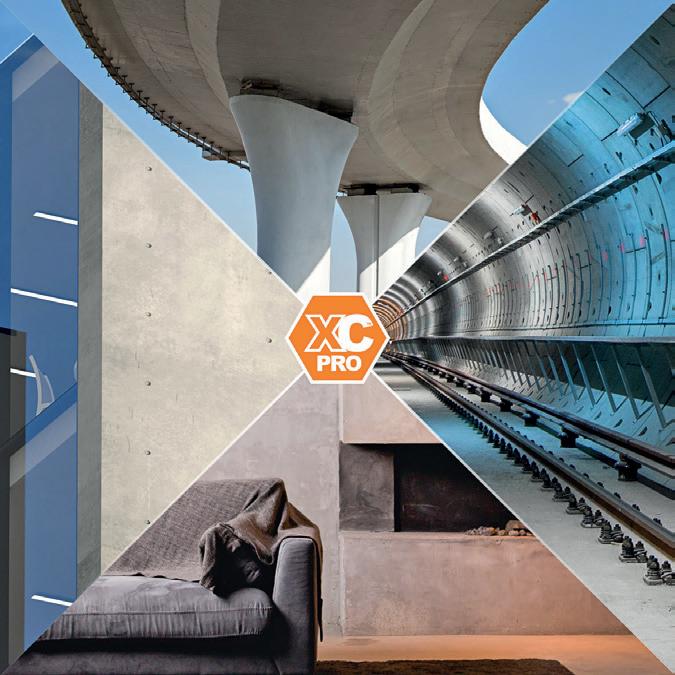
“For instance, I recently spoke with an engineer who simply checks whether a product has an ETA and considers that sufficient,” says McPherson. “They rely on software to input loads but don’t evaluate the specific performance data or understand the approvals’ specific implications.”
“ETAs are invaluable for providing transparency and enabling like-for-like product comparisons. But to gain the full benefit, engineers must engage with the detailed performance data within these documents.”
meet extended design life requirements, such as 100 years or more for major infrastructure projects,” he says.
“Additionally, fatigue loading approvals, which assess a product’s performance under cyclic stress, are becoming increasingly relevant, particularly for infrastructure like bridges and tunnels. We’re going to see ETA approvals reflect these trends in the coming years.”
The Hobson Engineering team is dedicated to educating customers on the practical applications of ETAs. For Australian engineers and contractors, understanding and applying these certifications can lead to informed decision-making, cost savings and improved project outcomes.
Hobson Engineering’s XCHEM range highlights the importance of aligning product performance with evolving industry demands. By leveraging ETA-approved solutions and deepening their understanding of how these certifications impact projects, construction professionals are better positioned to achieve compliance and adapt to emerging standards.
As ETAs continue to influence industry practices, Hobson Engineering remains steadfast in supporting engineers and contractors with expert guidance and dependable products.
“ETAs
provide a consistent framework for evaluating products across various categories and suppliers.”
The strength of ETAs lies in their ability to level the playing field. They offer a consistent standard that allows engineers to assess product performance with clarity, understand the underlying testing and make straightforward comparisons. Critical performance data for anchors is detailed within the ETA document, making it an indispensable tool for informed decision-making.
As the industry advances, ETAs are set to evolve further. McPherson predicts the next wave of approvals will focus on fatigue loading and extended design lives.
“For instance, most buildings today are designed for a 50-year lifespan. If we think back 50 years to the 1970s, many of those buildings are now being demolished and replaced. As construction evolves, there will likely be increasing demand for products that

For more information or tailored advice on ETA-approved solutions, reach out to the Hobson Engineering team.
has the right approvals to meet diverse technical specifications.
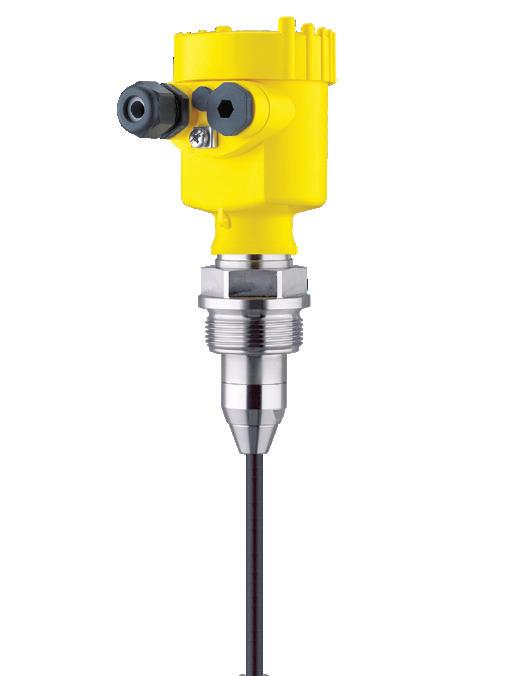




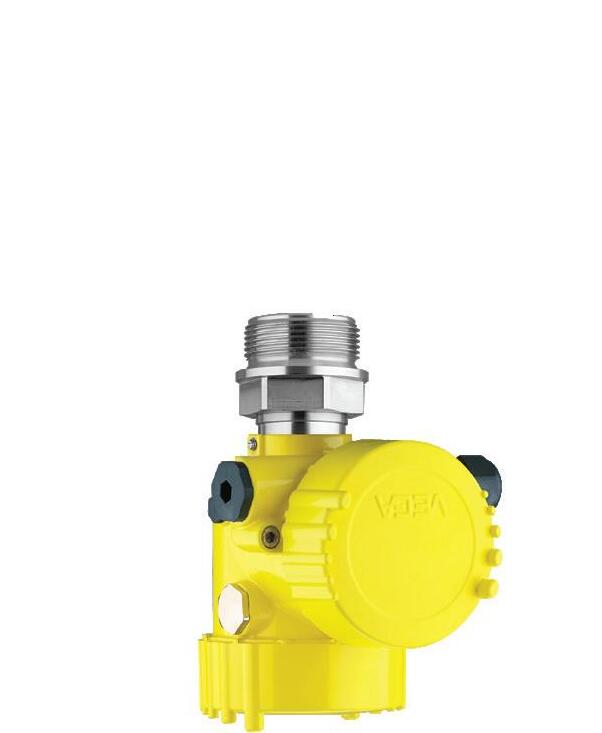
Touch down with VEGA’s comprehensive range of accurate and reliable pressure measurement sensors for all applications.
PROCESS, HYDROSTATIC AND DIFFERENTIAL PRESSURE.
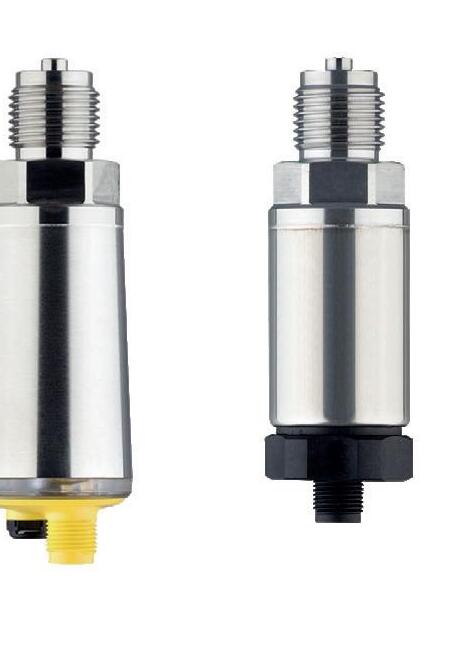
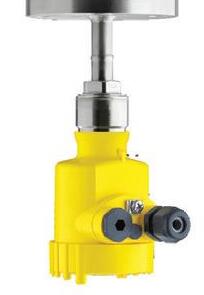
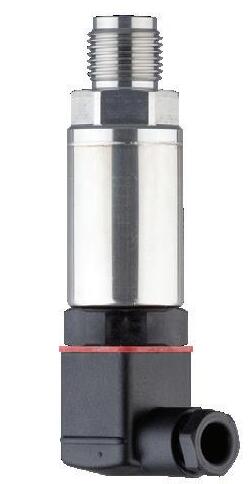



From slabs to skyscrapers, Jacon Equipment powers Australia’s construction projects with concrete pumping and shotcrete solutions tailored to every challenge.
“Our customers value the balance of usability, durability and value in our machines.”
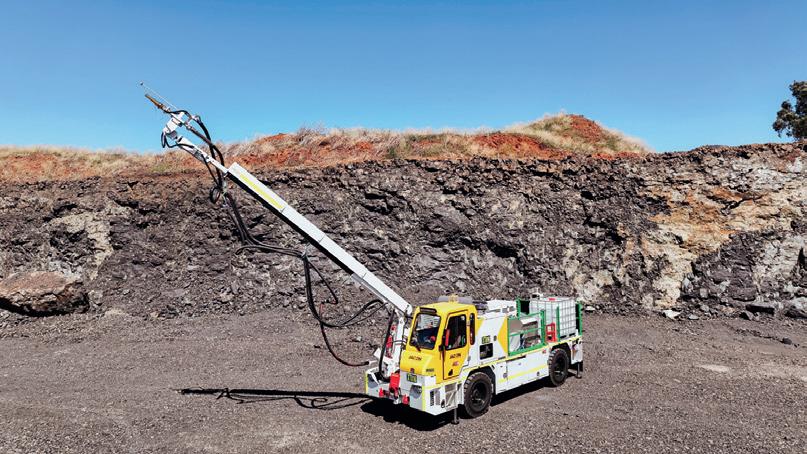
Since 1978, Jacon Equipment has been at the core of Australia’s construction industry.
suburban driveways, reinforcing a high-rise tower or tackling ambitious infrastructure

Jacon’s impact stretches beyond its robust machinery. At the heart of the company lies a commitment to forging lasting partnerships with customers.
“We’re not just selling machines; we’re partnering with our customers, delivering tailored solutions that drive long-term value,” says Darryl Simms, product specialist at Jacon.
“Many customers come to us unsure of what they need. We guide them to the right solutions, helping their projects succeed while saving time, cutting costs and boosting efficiency.”
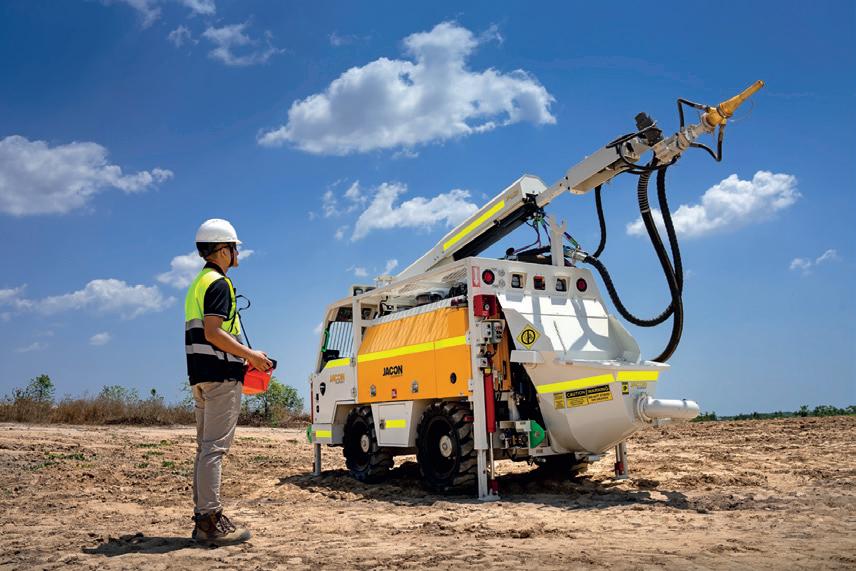
Jacon’s trailer-mounted and truck-mounted pumps exemplify flexibility, reliability and performance. With decades of engineering expertise, these workhorses adapt seamlessly to diverse construction applications.
The S-Series, for instance, offers trailer-mounted pumps with capacities ranging from 30 m3/h to Jacon’s flagship stationary pump, which delivers an impressive 100 m3/h. Available in diesel and electric configurations and with mounting options including trailer, skid or track, these pumps meet the unique demands of each job.
For contractors requiring more mobility, Jacon’s truck-mounted options, including the T60 and T100, provide a balance of power and versatility. The T60 delivers a capacity of 60 m3/h, while the T100 equals Jacon’s largest trailer-mounted models with 100 m3/h output.
“Our S-Series pumps are engineered with an ‘S’ valve that handles harsh mixes, low-slump concrete and fluid grout. They’re indispensable for applications ranging from concrete slabs and retaining walls to underground void filling, ground stabilisation and large-scale infrastructure projects,” says Simms.
“Our larger pumps are a mainstay in infrastructure projects across Sydney and Melbourne,” he added, underscoring their critical role in urban development.
Shotcrete solutions shine
When it comes to ground stabilisation and tunnelling, Jacon’s shotcrete rigs are game-changers. Two standout models, the MJ4.5 Midjet and the Maxijet MX3-M KII, demonstrate the company’s focus on innovation and functionality.
“The Midjet thrives in tight spaces,” says Matt Finn, another product specialist at Jacon. “Its compact design and AWD skid steering make it ideal for navigating narrow tunnels. Powered by diesel and equipped with a 10-metre vertical reach, it excels in challenging underground environments.”
For heavy-duty operations, the Maxijet MX3-MKII steps up. With a pumping capacity of 30 m3/h, its nozzle technology enables 360-degree rotation and 180-degree tilt for precise shotcrete application. Features like hydrostatic transmission, an enclosed
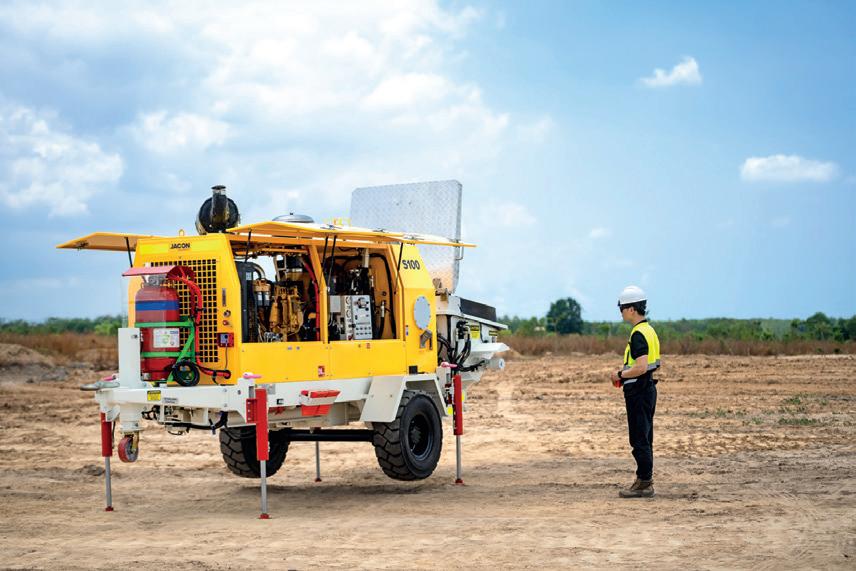
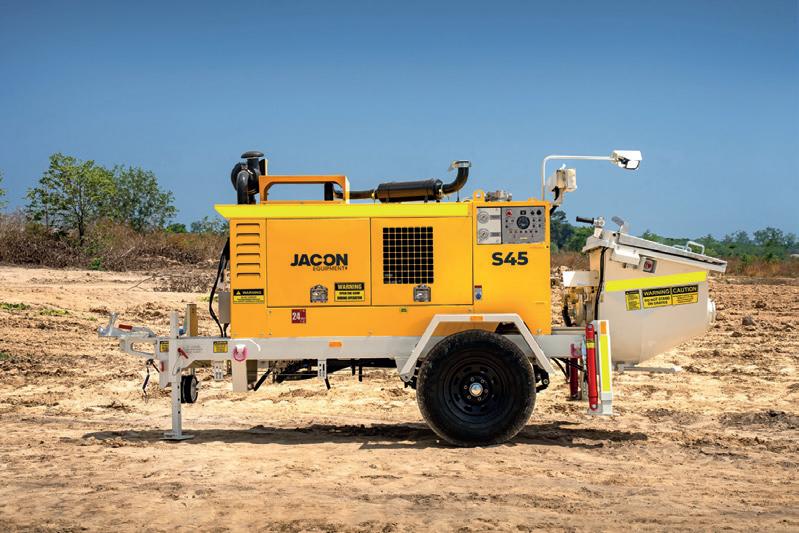
cab and an optional hybrid diesel/electric design further enhance its versatility.
“These machines are essential for securing slopes, reinforcing tunnel walls and stabilising construction ramps,” says Finn. “They prevent collapses, creating safer environments for workers and equipment.”
To ensure accurate application, Jacon equips its rigs with pre- and post-scan (PPS) systems that measure shotcrete thickness. By aligning with Tier 4 emission standards, these rigs also contribute to a more sustainable construction landscape – particularly important given Australia’s evolving environmental regulations.
“We’re
not just selling machines; we’re partnering with our customers, delivering tailored solutions that drive long‑term value.”
Jacon’s commitment to quality extends to every aspect of its operations, ensuring
state-of-t he-art facility in Vietnam, designed with standardised components that simplify maintenance and reduce downtime.
“Breakdowns are inevitable in this industry, but our machines are built to minimise their impact,” says Finn. “Clear schematics, accessible parts and interchangeable components ensure repairs are straightforward, keeping projects moving.”
The company also offers 24/7 breakdown support through offices in Sydney, Brisbane, Melbourne and Perth, complete with fully stocked parts inventories. Jacon’s training programs, including annual refresher courses, empower customers with both theoretical and practical expertise.
As the industry evolves, so does Jacon. The company is refining hybrid systems to reduce emissions while incorporating user-friendly, ergonomic features across its product line.
“Our customers value the balance of usability, durability and value in our machines,” says Simms. “While our standard pumps are robust and versatile, we also offer customised upgrades for specialised applications, ensuring every solution is tailor-made to meet specific project requirements.”
Central to Jacon’s ongoing success is its consultative approach. By understanding client needs, the company delivers machines engineered not just for performance but for
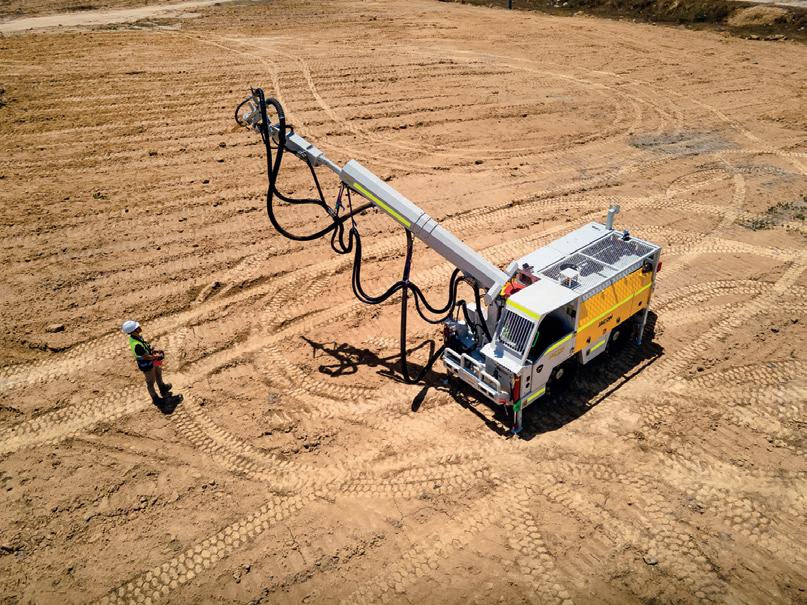

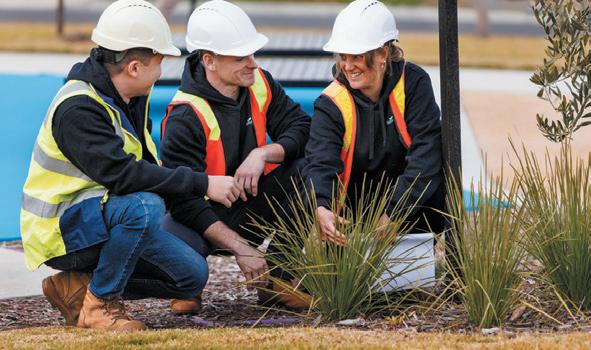

2024 – Victorian CCF People and Training Awards –Sustainability Excellence
2024 – Victorian CCF Earth Awards –Sunbury Road Upgrade project –Best project over $150 million

Thank you to our partners for sharing our vision and working together with us to achieve success.
We are thrilled that our commitment to sustainability is receiving industry accolades.
Winslow continues to be driven to find sustainable outcomes through innovative solutions.
Lathams Road Upgrade project:
Commendation IS Design Rating
Excellent IS As-Built Rating
Sunbury Road Upgrade project:
Excellent IS Design Rating
Excellent IS As-Built Rating
Lightweight, strong and versatile, light gauge steel framing made from TRUECORE® steel is a key structural component that enables this striking, curved masonry façade to take shape.
Project
The Round – Performing Arts Centre
Location
Nunawading, Victoria
Principal Steel Product
23 tonnes of light gauge steel framing made from TRUECORE® steel
Builder
Kane Constructions
Steel fabricator
CMG Frames
Architects
BKK Architects and Kerstin
Thompson Architects
Brick façade fabricator
Modular Masonry
Photography
CMG Frames, Modular Masonry and Derek Swalwell
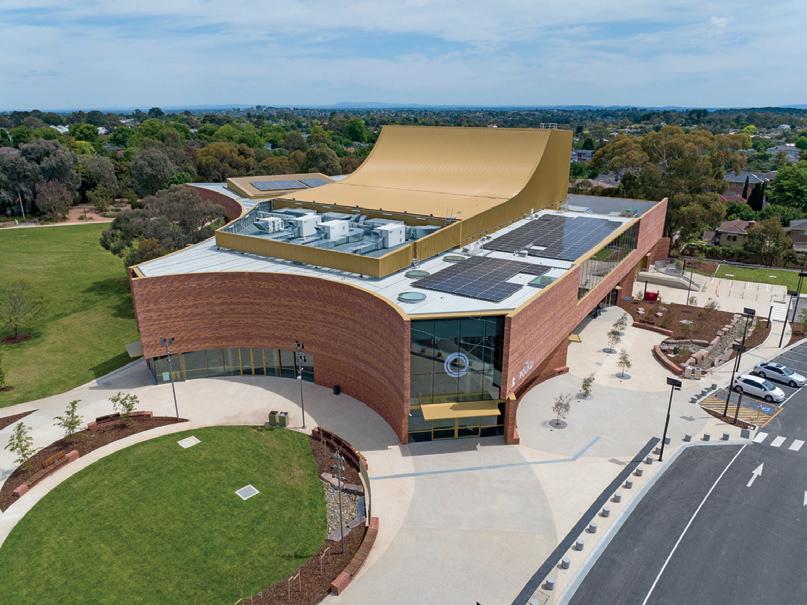
Set in the Melbourne suburb of Nunawading,
The Round is a performing arts centre that was commissioned by the City of Whitehorse to provide local residents with a facility for community engagement, performance, entertainment and celebration.
The Round performing arts centre replaced the 30-year-old Whitehorse Centre and incorporates a new 626-seat proscenium theatre, a 203-seat black box theatre, rehearsal studios, function rooms, and a large foyer area for pre-event hospitality. Additionally, one of the building’s curved exterior elevations provides the basis for a ‘sound shell,’ extending the centre’s theatrical spaces to an open-air amphitheatre.
Designed by BKK Architects and Kerstin Thompson Architects, the building’s imposing, curved, red brick façade was created to respond to its surrounding residential environment. Its distinctive shape was derived from a contextual map of the site, with circles drawn around the surrounding community zones: sports grounds to the east, family homes to the north and northeast,
parklands to the west and southwest, and the Whitehouse Road and council buildings to the south. The area remaining between these circles inspired the building’s concave-shaped footprint and distinctive façades, with each face of the building addressing a different community zone of influence.
The ground floor brick façade was constructed in the typical manner, using full bricks with mortar. However, in order to improve the overall construction program and delivery timeline, Kane Constructions identified an opportunity to use brick slips for the building’s upper levels. Early-stage collaboration between Kane Constructions, CMG Frames and Modular Masonry enabled the realisation of this solution. CMG Frames was engaged to develop an engineered light gauge steel (LGS) framing system that would support ‘thin bricks’ without compromising the architects’ design intent for the façades. Large LGS frames made from TRUECORE steel were prefabricated to support the second-storey brick façade, which was installed over several weeks rather

than months, as required with traditional brick-laying. An additional benefit was that the mobile lifting equipment used to position the prefabricated panels eliminated the need for scaffolding, ensuring internal trades could work concurrently.
development manager at CMG Frames, “The build was a large-scale, complex project which combined multiple curved and straight prefabricated wall panels to deliver a dynamic articulated façade. It required custom-made
frames, bespoke fixing brackets and 3D shop drawings integrated into the project’s overall BIM model. The 3D modelling approach taken reduced the reliance on RFIs (‘request for information’ to clarify documents, drawings, specifications or other project issues), which
“The build was a large-scale, complex project which combined multiple curved and straight prefabricated wall panels to deliver a dynamic articulated façade.”

“We’re proud to have partnered with Kane Constructions and Modular Masonry to help deliver such an iconic civic structure.”

architects need innovative solutions. Our approach combines prefabricated LGS framing with our brick slip façade system, providing a practical and efficient solution to meet these challenges.”
Engineered by LD Consulting Engineers, the curved frames use laser-cut profiled
Each face of the building addresses a different community zone of influence.
(Image: Modular Masonry)

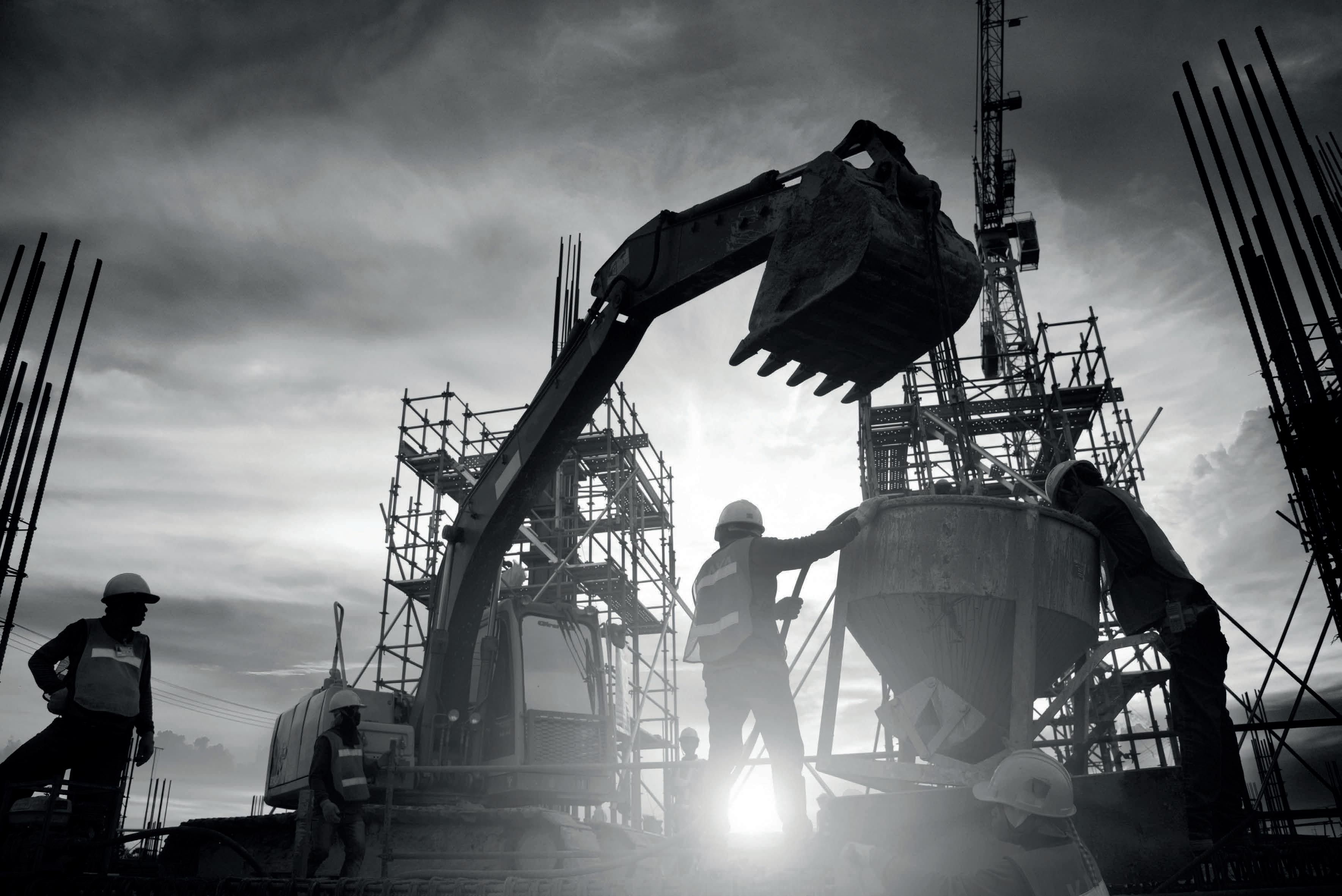

Converge is Australia’s premier event for Sub-Contractors, Project Engineers, Council Fleet Managers, and Large-Scale Construction Contractors across the municipal works, civil construction and infrastructure space.
Through a mixture of live demonstrations, equipment showcases, and conference spaces, Converge will bring industry experts together to share knowledge and deliver solutions for building and maintaining Australia’s future.
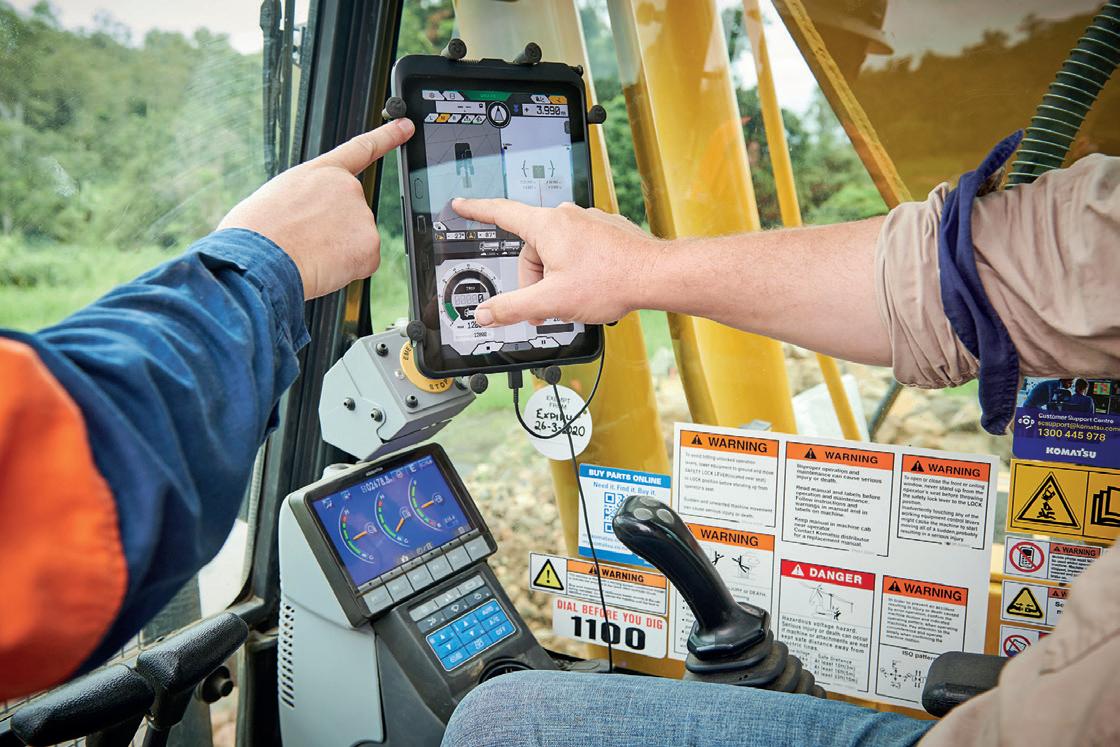
Komatsu is rewriting the construction playbook, merging technology and smart machinery with expertise to deliver productivity, sustainability and safety on worksites.
The construction industry is experiencing a seismic shift, driven by increasing demands for smarter and greener solutions. Leading this evolution is Komatsu, combining a century of expertise with modern technology to redefine what’s possible in project delivery. Through its expanding Smart Construction solutions, Komatsu is transcending individual machines to create smarter, more connected worksites. This holistic approach improves efficiency, lowers emissions and enhances safety – addressing the evolving challenges and priorities of major Australian projects.
Productivity in construction is one persistent challenge affecting the sector. Labour productivity declined by 1.8 per cent during the 2022-23 financial year, according to the Australian Productivity Commission’s 2024 report. Disconnected equipment and siloed data have hindered progress, but Komatsu’s Smart Construction solutions are bridging these gaps.
James Muir, general manager of Smart Construction at Komatsu, says the company’s
success is driven by the agnostic nature of its technologies, which integrate with equipment from other manufacturers.
“Centralised data empowers customers to make informed decisions, ensuring compatibility with existing tools and solutions,” says Muir.
A standout innovation in Komatsu’s lineup is the Smart Quarry Site platform, a fleet management solution. By providing real-time data on machine performance, production and safety, it ensures materials are moved efficiently, reducing waste and fuel consumption. The platform supports machines from multiple brands, fostering a more connected and collaborative environment.
These operational efficiencies can translate into environmental benefits. The built environment is responsible for 40 per cent of global carbon emissions, with 22 per cent attributed to embodied carbon in construction and infrastructure, as highlighted in KPMG’s 2023 Embodied carbon in construction and
infrastructure report. Komatsu is tackling this challenge with a proactive approach to sustainability.
Intelligent Machine Control (iMC) technology helps operators avoid over-d igging or unnecessary rework, reducing fuel consumption by up to 30 per cent. On large-scale projects, these efficiencies quickly add up.
With Smart Quarry Site, the material distribution in truck trays is displayed via a digital spirit level indicator, ensuring even loads. This maximises capacity, improving loading efficiency while reducing the number of trucks and cycles required.
“By optimising loading cycles, our customers achieve greener outcomes while cutting operational costs,” says Muir. “For one company, Smart Quarry Site saved more than 80,000 litres of fuel and reduced CO2 emissions by 217 tonnes in just 12 months.”
Komatsu’s sustainability efforts surpass operational improvements. The company is advancing electric excavators, hydrogen fuel cell technology and power solutions
to meet environmental targets without compromising performance.
“We have released Tier 4 engines, reducing particulate matter and nitrogen oxides (NOx) emissions, even though Australia has not yet mandated this standard,” says Muir.
“In Europe, Tier 5 is already required and supplied by Komatsu, so as a country we are lagging. Still, we remain committed to delivering solutions that drive global environmental goals.”
While moving the needle on sustainability, Komatsu is equally focused on enhancing safety in one of Australia’s most hazardous industries. In 2023, machinery operators and drivers accounted for 37 per cent of all worker fatalities, according to Safe Work Australia’s 2024 report.
Safety is non-negotiable, and Komatsu prioritises people alongside sustainability and performance. Intelligent features like 360-degree KomVision surround cameras, payload measure and capture and aerial
“For one company, Smart Quarry Site saved more than 80,000 litres of fuel and reduced CO2 emissions by 217 tonnes in just 12 months.”

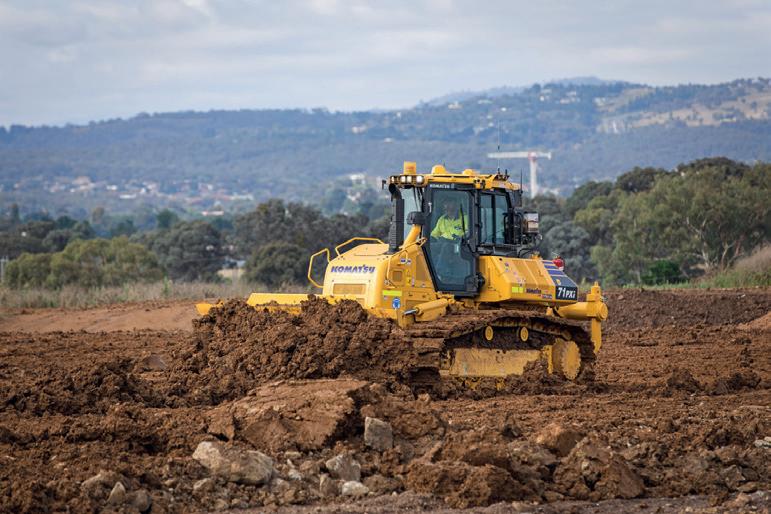
hazardous areas while increasing accuracy.
“Our iMC systems deliver survey-grade precision without putting workers at risk,” says Muir. “Surveyors no longer need to enter pits or traverse unstable ground because machines operate using real-time digital design data.”
Komatsu also employs training technology, such as machinery simulators that provide immersive learning environments. These tools allow operators to hone their skills in a controlled, risk-free setting before stepping onto live worksites.
Advancing autonomous construction
Komatsu’s technologies are accelerating the vision of more autonomous construction sites – a reality that is rapidly taking shape.
“Autonomous machines are not replacing people; they are creating new roles,” says Muir. “These machines can operate consistently,
24/7, without fatigue, enabling skilled workers to focus on tasks requiring oversight and expertise.”
Komatsu is partnering with engineering firms and contractors to ensure its innovations benefit entire project sites rather than isolated workflows. This approach delivers productivity gains across the value chain and reductions in resource waste.
Collaboration fuels innovation
Komatsu’s success thrives on a commitment to collaboration. Each new solution, from Smart Quarry Site to future iMC advancements, is shaped by customer input and real-world challenges.
“The voice of the customer drives everything we do,” says Muir.
“Our solutions are not about quick fixes –they are about delivering tools that provide measurable value today and scalable benefits tomorrow.”
While the construction industry is still years away from achieving autonomous worksites, Komatsu’s suite of smart solutions is laying the groundwork. From electric excavators to hydrogen-powered machinery, Komatsu is building a future where construction is safer, greener and more efficient. With iMC 3.0 on the horizon, the company’s 100-year legacy continues to evolve – its journey is far from over.
“The voice of the customer drives everything we do.”
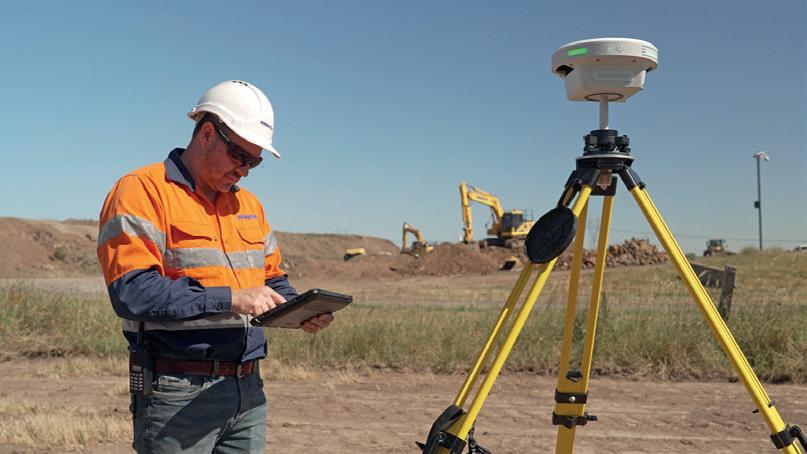









Hala Taouk has traded fitting in for standing out, carving her path in the construction industry with authenticity and unwavering enthusiasm.
Speak with Hala Taouk, senior commercial manager at CIMIC Group’s UGL, and it quickly becomes clear: she is proudly herself – passionate about construction and a natural leader. But this sense of authenticity was hard‑won, honed over many years of perseverance and self d iscovery.
A civil engineering graduate from the University of New South Wales, Taouk wasted no time diving into the construction world. Her debut project – a high r ise building in Sydney – saw her stepping onto a site as the sole woman among 200. While many might have been daunted by such an environment, Taouk rose to the challenge, overcoming obstacles and emerging stronger in the process.
Reflecting on it now, despite its challenges, she says she enjoyed the experience.
“I started as a site engineer and, as I like to say, earned my stripes. The great thing about being on a construction site is the authenticity – there’s a level of genuine connection I haven’t seen elsewhere,” says Taouk.
“By the end of a project, it often feels like you’ve become a family because everyone is working towards a common goal every single day.
“Even though I graduated with a civil engineering degree, I realised I wanted to be part of that atmosphere. That, and I loved the smell of fresh concrete in the morning.”
testament to how the industry had grown to embrace individuality.
“Back yourself and be yourself,” says Taouk. “Don’t try to be one of the boys – your strength lies in doing things your way. That’s the key takeaway I want women to know.”
Taouk’s identity as a Lebanese Australian also plays a vital role in her story. Although born in Australia, she spent her teenage years in Lebanon before returning at 18 to study engineering on her own. This experience instilled a profound resilience.
“I’ve realised that embracing my whole self – both as a woman and as someone from an ethnically diverse background – is a strength,” she says. “Times have changed, and so has the way people appreciate diversity, both cultural and personal.”
At a company she previously worked for, Taouk experienced the power of diverse perspectives in an operations role within the company’s digital business. Collaborating with architects, engineers, software developers and user experience consultants reinforced the value of authenticity and confidence.
“Your personal brand is what sets you apart,” she says. “When you embrace it, you not only advance your career but also make a meaningful impact.”
“I’ve realised that embracing my whole self – both as a woman and as someone from an ethnically diverse background – is a strength.”
While Taouk looks back on the experience with fondness, recognising how it helped shape the leader she is today, she’s also grateful to see how the industry has progressed. Her male colleagues often struggled to know how to communicate with her, and she, in turn, found it challenging to connect with them.
“Fast forward 20 years, and I’ve seen significant progress,” she says. “People have become more aware, and with awareness comes understanding. I don’t see men resisting these changes. Quite the opposite – I see them actively promoting and supporting women, even with gestures like wearing pink shoelaces to show solidarity.”
A defining moment in her career came years later, when she shared a site office with a female engineer sporting fluoro purple nails and reading Vogue during lunch. It was a far cry from her early days – a
With a career spanning iconic projects like Sydney’s Darling Square, Taouk is now working on the HumeLink West transmission project being delivered by CIMIC Group companies, UGL and CPB Contractors for Transgrid Group. The initiative, which will deliver renewable energy to Australian households, holds special significance for her.
“This is a once i n a generation opportunity,” she says. “Being part of a project that powers homes with renewable energy is incredibly meaningful. It’s something I’m proud to share with my kids and friends.”
Taouk’s days are as varied as her career. Mornings begin early, juggling emails and family routines. Work often involves tackling procurement issues, managing teams and ensuring regulatory compliance.
“To excel as a commercial manager, you need to be a jack of all trades, master of none,” she says. “The role requires a combination of skills – part engineer or construction professional, part lawyer, part accountant, and, most importantly, an effective communicator.”
(Image: HumeLink West JV)
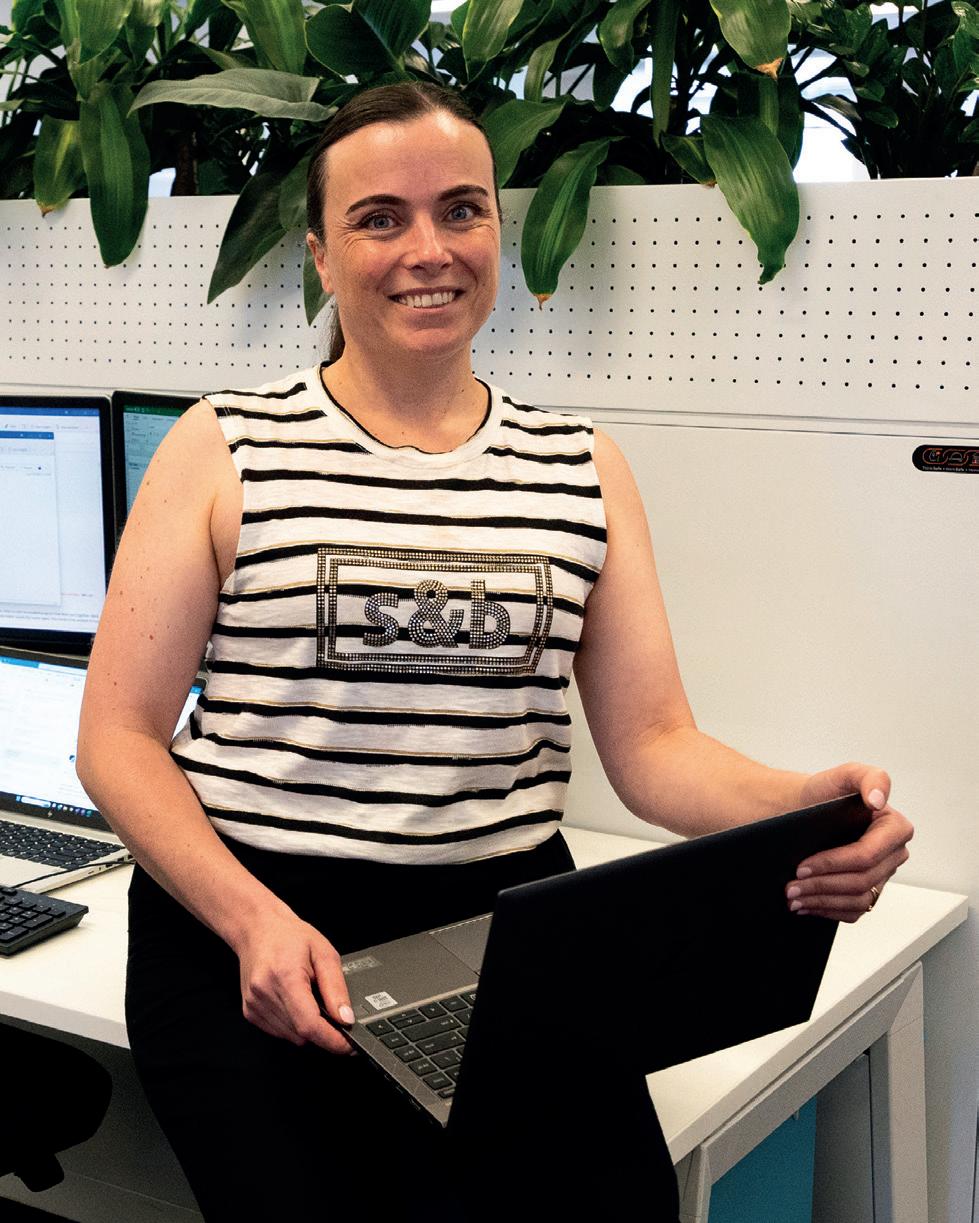
requires a blend of process d riven activities and reactive problem solving.”
She also takes pride in fostering seamless communication between her team and senior management, ensuring ideas are heard at all levels.
“As a manager of managers, I act as a conduit,” she says.
“Whether it’s the most junior team member or senior leadership, my aim is to create harmony and let the best ideas drive decisions.”
she says. “I’ve moved up, sideways and beyond, always seeking new challenges. It’s a dynamic, exciting path.”
For now, Taouk’s focus remains on the HumeLink West project, but she also has her sights set on operations management.
“It’s all about people, oversight and leadership, which really excites me,” she says. “Beyond that? The sky’s the limit.”
With her passion and authenticity lighting the way, it seems the sky truly is the limit for Hala Taouk.
“My journey proves engineering isn’t confined to design offices or calculations.”
Building on recent strides towards a more collaborative industry, the Australian Constructors Association announces the return of Foundations and Frontiers in 2025.
It’s 2025 and time to rethink the rules. Construction has been stuck in a ‘winner takes all’ mindset for too long. Gains for one party have often come at the expense of another. This zero-sum approach has fuelled inefficiency, mistrust and missed opportunities. But what if we flipped the script? What if collaboration replaced conflict, and construction became an industry where workers, government and businesses could succeed together?
In 2024, the Australian Constructors Association (ACA) launched the Foundations and Frontiers forum (FF24) – a bold step toward rewriting the future of construction. Inspired by global summits like COP and Davos, FF24 wasn’t just another industry event; it was a game-changer. Sector leaders came together,


setting the stage for Australia’s first-ever National Construction Strategy (NCS) – a plan to transform how the industry works. The NCS will focus on four critical areas:
• P rocurement – harmonising procurement practices to improve productivity and deliver better value outcomes.
• Workforce – identifying new skills to increase productivity and strategies to attract and retain the future workforce.
• Data – determining the data needed to measure productivity improvements and developing methods for its collection, anonymisation and sharing.
• Innovation and modern methods of construction (MMC) – identifying current best practices, exploring ways to increase their adoption, and addressing barriers to innovations and MMC. ACA is spearheading this stream.

Foundations and Frontiers
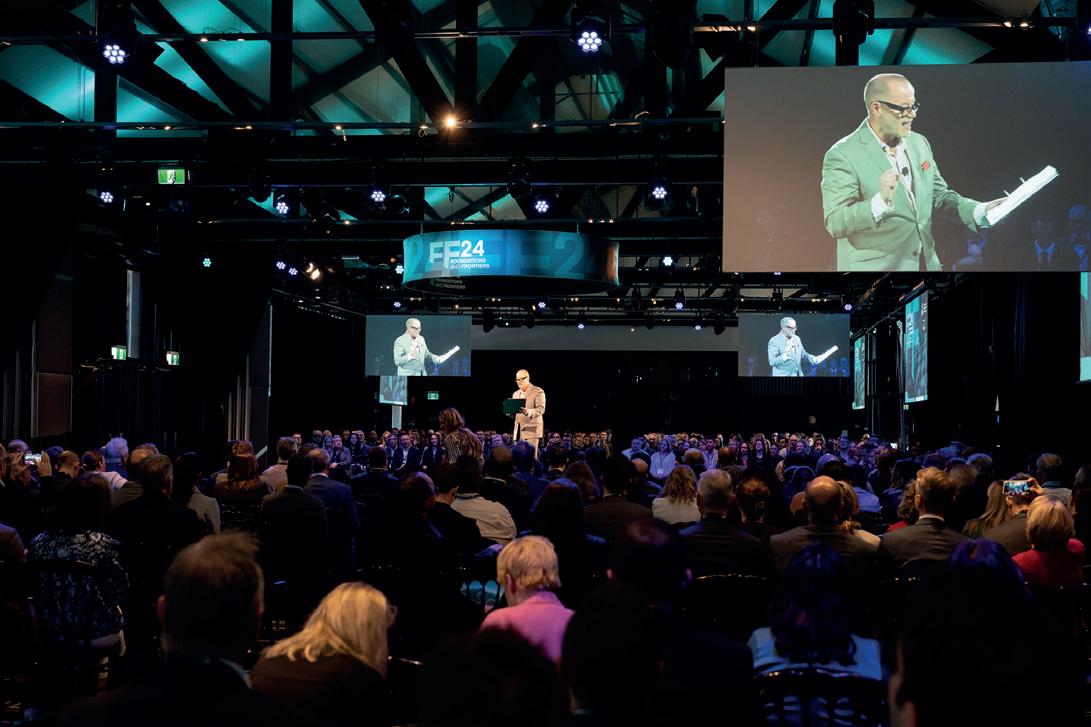
the NCS’s launch and spark more momentum for positive change.
Not your typical conference
FF25 isn’t about long speeches or endless PowerPoint slides. It’s designed to be fast, interactive and energising. Think TED-style talks, hands-on discussions and creative formats that keep the conversation lively and solutions-focused.
Last year’s highlights included the ‘Construction Great Debate’ on market intervention and the ‘Deal or No Deal’ session on managing risks – both huge hits with attendees. FF25 will take these successes further, with more innovative sessions to challenge traditional thinking and ignite fresh ideas.
Driving change
FF25 is more than just a one-day event – it’s a movement for lasting progress. The day
A forum for everyone
FF25 is for anyone passionate about improving the construction industry – not just CEOs and executives. Whether you’re a contractor, supplier, consultant, union member or financier, you’re welcome here. The event will bring together people from all corners of the industry, alongside representatives from unions, state and federal governments, and other key stakeholders. Last year’s FF24 was called “transformative” and “the best interactive event I’ve attended,” drawing 600 participants eager for change. FF25 promises to be even bigger, with more opportunities to collaborate and drive change.
Inside Construction is a proud partner of Foundations and Frontiers. Visit the event website for more information: www.foundationsandfrontiers.com.au
“What
if collaboration replaced conflict, and construction became an industry where workers, government and businesses could succeed together?”
Ozcast’s role in the Berry to Bomaderry section of the Princes Highway Upgrade showcases the company’s ingenuity and commitment to quality.
“Beyond the design and production, Ozcast addressed the panels’ longterm durability through in-house testing of antigraffiti coatings.”

The Berry to Bomaderry section of the Princes Highway Upgrade in New South Wales is a landmark project designed to improve safety, traffic flow and accessibility along one of the state’s busiest transport routes.
The upgrade addressed longstanding challenges, including traffic congestion and accident-prone areas, while integrating aesthetic enhancements to harmonise with the natural surroundings. A critical component of the project was the installation of shotcrete walls featuring patterned silver fascia panels, combining functionality with visual appeal.
In 2019, Seymour Whyte entrusted National Precast member Ozcast with a challenge: to produce 209 patterned silver fascia panels for the shotcrete wall. Each panel was to be slightly different, creating a seamless yet varied aesthetic. However, fabricating 209 unique designs would have been time-consuming and costly.
Demonstrating ingenuity, Ozcast optimised production by batching the panels into 60 different types instead of 209, maintaining the
desired variation while reducing production complexity. By casting panels in sets of three, Ozcast achieved precision while introducing production tolerances that streamlined the manufacturing process. This approach not only saved time but also reduced costs, making the project more efficient without compromising on quality.
Beyond the design and production, Ozcast addressed the panels’ long-term durability through in-house testing of anti-graffiti coatings. The selected product balanced aesthetic preservation with functional resilience, ensuring that the panels remained visually striking and easy to maintain over time. This proactive step minimised future upkeep costs, aligning with the project’s goal of creating a sustainable and low-maintenance solution.
stunning and functional result
The completed shotcrete wall stands as a testament to the transformative power of innovative precast solutions. The patterned silver fascia panels create a visually

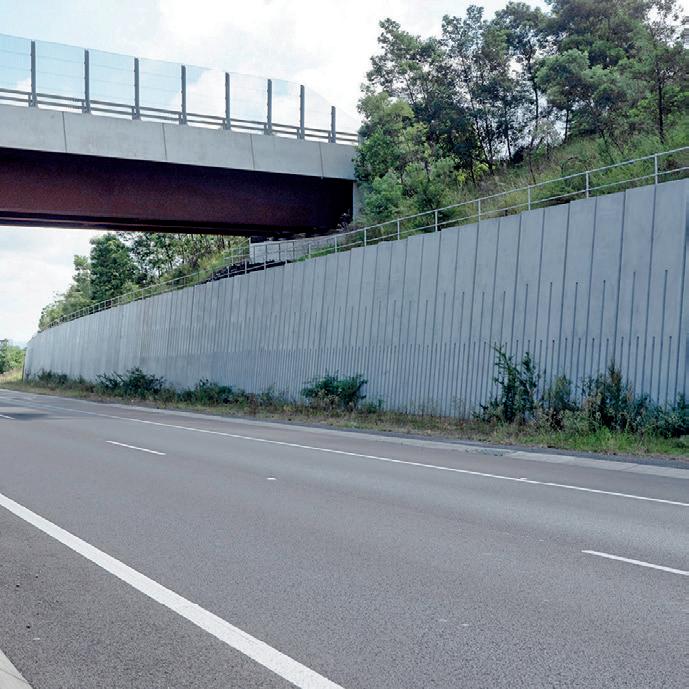
engaging barrier that complements the natural landscape while enhancing safety and structural integrity. Ozcast’s efficient production methods and attention to detail ensured that the panels not only met but exceeded the project’s aesthetic and functional requirements.
The reduction in the number of unique panel types and the successful implementation of anti-graffiti coatings resulted in time and cost savings, highlighting Ozcast’s ability to deliver high-quality results under demanding conditions.
The Berry to Bomaderry section of the Princes Highway Upgrade underscores the value of collaboration in infrastructure projects. Ozcast’s work showcases the potential for precast concrete solutions to combine durability, aesthetics and cost-efficiency.

The project’s success serves as an example of how innovative approaches can address complex challenges while delivering lasting benefits to the community.
By reducing the number of panel designs from 209 to 60 types, Ozcast streamlined production, achieving time and cost savings. The company’s in‑house testing of anti g raffiti coatings ensured long term durability and low maintenance, preserving the panels’ aesthetic and functional integrity. This project highlights the versatility of precast concrete solutions, blending safety, style and sustainability to enhance one of New South Wales’ most critical transport corridors.
“A critical component of the project was the installation of shotcrete walls featuring patterned silver fascia panels, combining functionality with visual appeal.”
Empowered Women in Trades is gearing up for a transformative 2025, championing progress and opportunity.

“You cannot be what you cannot see, and our programs allow you to experience a day in the life as we explore career options.” in Trades.
I’ve always liked the start of a new year; it is like having a blank canvas just waiting to be filled with colour, and 2025 is no different. As we head into 2025, the Empowered Women in Trades (EWIT) team is excited about all the opportunities to come as we continue to push towards our vision of 30 per cent of trade-based roles being filled by women by 2030.
Each year, the EWIT team has a word of the year – something that reminds us why we continue to be disruptors, why we are changemakers and who we do this for. Our word for 2025 is one we have used before but holds such power and meaning: impact.
The Cambridge Dictionary defines “impact” as “a powerful effect that something, especially something new, has on a situation or person”. Everything we do, every program and event we deliver or attend, must have
What is your word for 2025?
Let’s give you a sneak peek into the initiatives the EWIT team will be up to in 2025 to continue to disrupt, make change and have impact.
We will see an increase in our school-based programs via our Kicking Goals in Trades program, connecting more secondary school students to trades pathways and helping them explore career options in a psychologically safe and supported environment. Our programs showcase how important trades are to all other careers; they take a deeper look at the skills and attributes needed and support students to get on the tools and be as comfortable with a drill as they would be with a pen.
The Women in Trades networking events will be rolled out to New South Wales, Victoria, South Australia and Queensland in

connections and support tradeswomen in remaining in the industry and exploring career development opportunities. These events are delivered in collaboration with Carpentry Australia and Apprenticeship Support Australia.

will see our talent attraction programs delivered across Australia to provide women with opportunities to connect with jobs, experience different trades, and build confidence and knowledge. You cannot be what you cannot see, and our programs allow you to experience a day in the life as we explore career options.
Our cultural programs, including Empower Minds and Thrive workshops, will be delivered as we work to support people to be better for each other. The programs
wellbeing and to break systemic, deep-rooted things we love.
Our village will continue to grow as we partner with like-minded organisations, industry partners and education departments to disrupt stereotypes through our EWIT Alliance.
And the rest? You will have to wait. Make sure you like and follow our social media pages to get involved, and remember, we may not be able to change the world, but together we can be world-changing. Let’s do this, 2025.
“Everything we do, every program and event we deliver or attend, must have impact; otherwise, why are we doing it at all?”
The National Association of Women in Construction reflects on a huge year of advocacy achievements.
“Starting the year with a bang, we focused on one of our five priorities – appropriate facilities.”
In 2024, the National Association of Women in Construction (NAWIC) championed advocacy by delivering key campaigns in conjunction with our chapters, focusing on our core priorities for change and reform across the sector.
Starting the year with a bang, we focused on one of our five priorities – appropriate facilities. For too long, women have been required to travel to, share, or use unsafe toilets – or, worse, have no access to toilets at all. This issue is critical not only for women’s safety but also for all workers, particularly those with gastrointestinal-related illness.
In Australia, every state and territory require employers to provide “appropriate facilities.” But what does this mean? While the government has not specifically defined what constitutes an appropriate toilet, it has set out minimum requirements, which include:
• Fitted with a hinged seat and lid.
• Adequate lighting and ventilation.
• Clear signage.
• A h inged door capable of locking from each side of the cubicle.
• P rivacy for users ensured through positioning.
• Separation from other rooms by an airlock, a soundproof wall and a clearly marked separate entrance.
• Supplies including toilet paper, handwashing facilities, rubbish bins and, for female workers, hygienic disposal for sanitary items.
move into leadership roles are a key part of encouraging women to enter the industry. We hear from our members that they do not always feel there is a place for them in leadership within their organisations.
NAWIC is developing a framework to support companies and individuals by identifying barriers and providing practical guidance on increasing the representation of women in leadership. The barriers to women in leadership include:
• L ack of mentorship, support and guidance.
• Male-dominated workplace cultures.
• L ack of flexibility upon women’s return to work.
• L ong working hours and rigid work structures.
• Sexual harassment.
• G ender pay disparity, and more.
For women in the construction industry, microaggressions play a large role in the low rates of retention, job satisfaction, promotion, representation and more. Microaggressions are seemingly small, indirect and subtle jabs that happen often and are widely felt. They can take the form of insensitive statements, questions or assumptions and are linked to the unconscious bias of the aggressor. By themselves, they may seem little, but over time, their cumulative impact is not-so-little.

For mobile workplaces, employers are responsible for locating and providing access to toilets and allowing additional time for travel in addition to regular breaks. For remote workers, employers must provide portable toilets in a secure location with safe access. Do your workplace toilets meet these standards? Inadequate or unsafe toilet access is a workplace safety risk. Every worker has the right to accessible and safe facilities.
In July, we conducted research into the top 20 construction companies and developers, which showed that, on average, less than 20 per cent of the leaders in these companies are women. Opportunities for women to
The not-so-little things affecting women in construction report underscores the importance of addressing microaggressions within the industry. As evidenced by the data and personal anecdotes shared, these seemingly minor acts of discrimination can have personal, professional and financial impacts on those who experience them. Recommendations for cultural change from the report include:
• Education and training for line managers and supervisors.
• Facilitated roundtable discussions with industry decision-makers.
• Creation of tools to understand organisational cultures.
• Independent complaints/whistleblowing line.
• Subsidised legal support – NAWIC members can now access free legal advice.
• G overnment lobbying, and more.

It is our hope and goal that this report will serve as the catalyst for change, prompting organisations to reevaluate their cultures, implement effective measures to counteract microaggressions, and create a more inclusive and respectful working environment for all.
What’s next
NAWIC national chairperson Jennifer Gillett, interim general manager Kylie Judd and CEO Cathryn Greville have met with multiple federal ministers and senior Commonwealth officials to outline NAWIC’s agenda, ensuring we remain front of mind
leading into a likely federal election in 2025. These engagements have included meetings with federal ministers, and active discussions with multiple departments and regulators, both federally and in Victoria. NAWIC has also appeared on radio, participated in panels, and been represented in roundtables to talk about issues impacting our members. We will continue to highlight the importance of changing behaviours and cultures to ensure more women are represented, entering and supported in the construction industry.
“Opportunities for women to move into leadership roles are a key part of encouraging women to enter the industry.”
NexGen’s primary program is helping forge the next generation of construction pioneers.
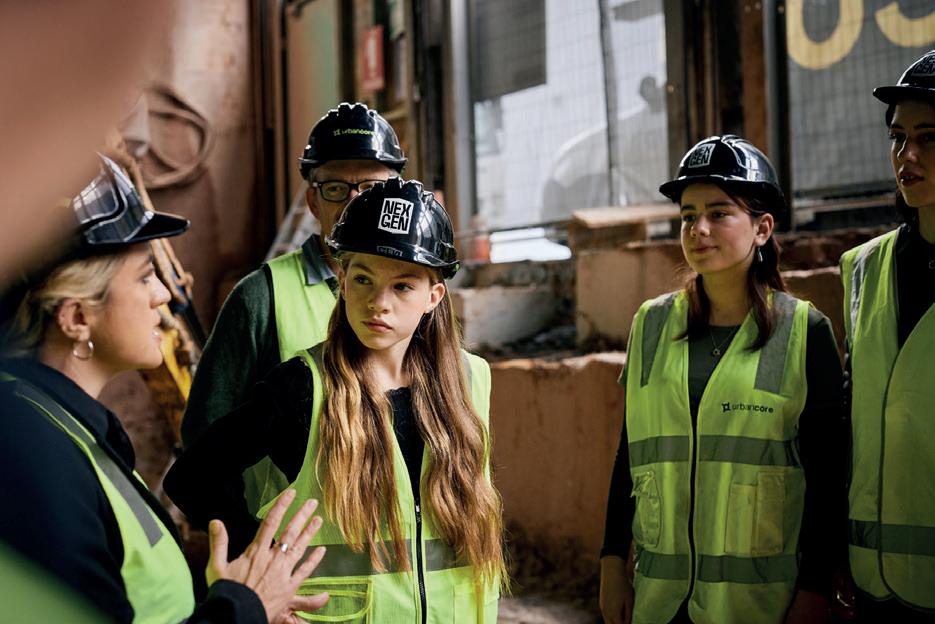
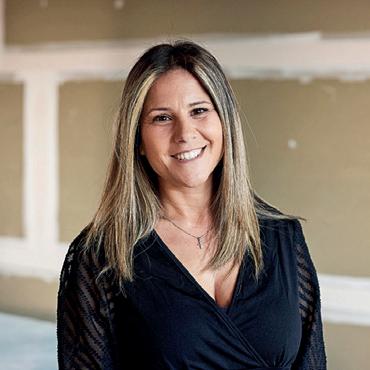
By Lauren Fahey, executive director
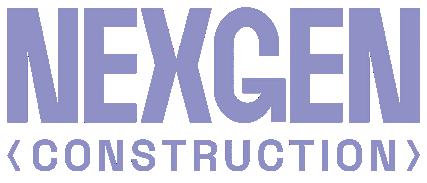
In Term 4 2024, NexGen delivered its brand‑new primary program to more than 200 eager Kindergarten and Year 1 students, aged five to seven years old. The result? Pure magic. These tiny but curious minds were captivated, and we left the classrooms knowing we’d made a difference – not just for today, but for their futures.
When you’re five, your imagination has no limits. You believe you can be an astronaut, a pilot or a superhero. But often, our societal norms sneak in early. A man in a suit? He’s the boss. Someone in hi v is? Just another worker. A woman in any role? Unseen. At NexGen, we’re here to smash those outdated ideas. This program was designed to meet kids where they’re at – full of wonder and potential. By showing them that leadership, creativity and innovation can wear hi v is or come from anyone, regardless of gender, we’re helping them see the world differently. And honestly, we do what we do because of the smiles on their faces as they discover that they, too, could build skyscrapers or design bridges.
To spark their imaginations, we shared stories from two incredible Australian books: This Girl Built That and I Want to Be an Engineer. The kids were gripped. Through these stories, we opened their eyes to endless possibilities, showing how problem solving and creativity can come together to create something amazing.
But it didn’t stop there. We gave their teachers curriculum mapped lesson plans to keep the momentum going, so the learning continued long after we left. We also gifted the school two construction t hemed books for their library. It’s our way of ensuring these young dreamers have resources to keep exploring and believing in their potential.
We all know the construction industry is facing a massive skills gap. But here’s the thing: this gap isn’t just about numbers. It’s about missed opportunities for innovation and progress. By introducing these young minds to the possibilities in construction early, we’re setting the stage for a brighter, more inclusive future.
Imagine a generation of kids who grow up seeing that building a bridge can be as artistic as painting a masterpiece and that designing a city’s infrastructure is just as inventive as creating the next big app. These kids will become the leaders and problem solvers who shape our future communities, and it begins with moments like these.
The success of this program isn’t just in the numbers (though we’re thrilled to have reached over 200 students); it’s in the way these children started to see construction not as a job but as a platform for creativity and leadership. We’re breaking down barriers, one classroom at a time.
As these kids grow, we hope they carry with them the belief that anyone can lead, anyone can build and anyone can create. Whether it’s a little girl imagining herself as a site manager or a young boy dreaming of designing sustainable cities, these shifts in mindset are what will change the world.
If your company wants to be part of this journey, we’d love to hear from you. Together, we can keep building something extraordinary. Reach out to us at hello@nex-gen.au

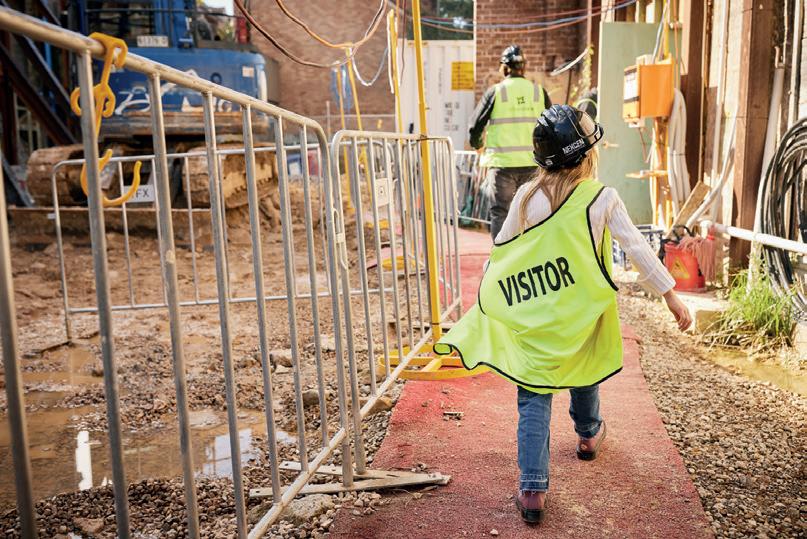
“By
introducing these young minds to the possibilities in construction early, we’re setting the stage for a brighter, more inclusive future.”
Dr Gretchen Gagel explores how understanding purpose, values and self-awareness shapes the foundation for effective leadership.
“I developed the Grounded Self‑Leadership model as a starting point for reflection and understanding of who you are as a leader.”

Have you ever experienced a situation where you were working with someone, and you began to question their motives? Or perhaps you were not certain that their values aligned with yours? Or even what their values were? Perhaps this person did not have the courage to make difficult decisions, or they were not effectively processing information to make informed decisions. You began to question their ability to lead.
Many people think that leadership starts with how you interact with others. I believe leadership starts with you.
One of the greatest outcomes of writing my book on leadership in the construction industry was that it caused me to reflect upon my time as a leader, my time spent advising
and observing leaders in our industry, and my PhD studies in leadership. While our ability to build strong relationships and influence others is a critical component of effective leadership, I believe that strong leadership begins with understanding ourselves. I developed the Grounded Self‑Leadership model as a starting point for reflection and understanding of who you are as a leader.
The Grounded Self-Leadership Framework Living Your Life Purpose and Values – Think of a leader you admire. I am going to guess that if I asked you what this person stands for, you could answer that question. This person may stand for quality, they may stand for innovation, they may stand for fairness. The point is that
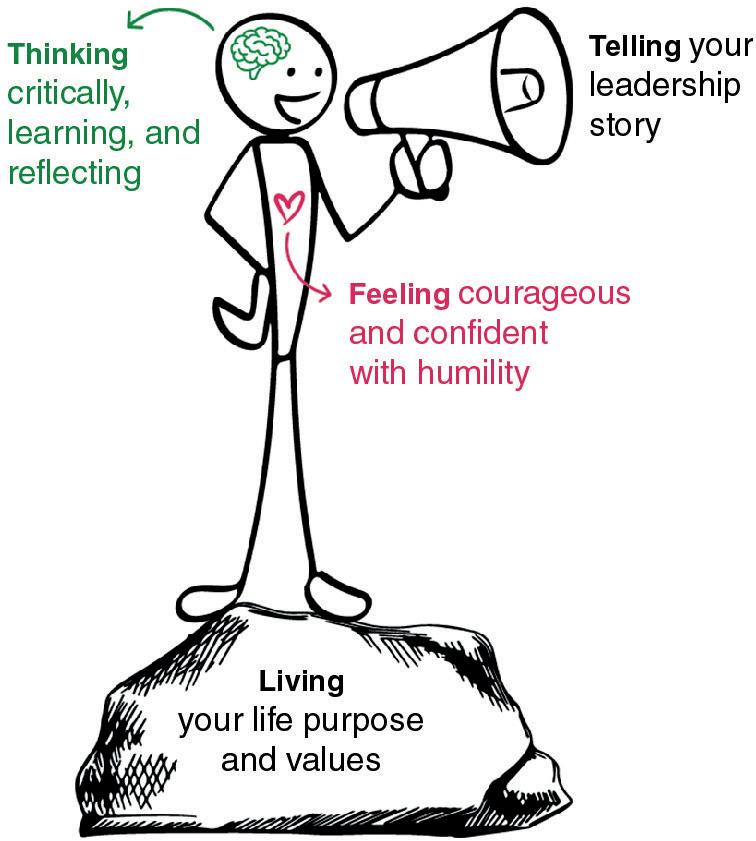
you know what they stand for. I believe that great leadership is grounded in knowing your values and having the courage to stand for these values. This, combined with your personal purpose, what you hope to achieve in life, is the foundation of great leadership. People want to follow people who have conviction and passion for what they do, and a strong moral compass that guides their actions and behaviours.
Feeling Courageous and Confident with Humility – The construction industry can be a challenging setting for courage and confidence. Our teams face incredible challenges such as solving the technical complexities of our projects while facing demanding schedules, all while keeping our people safe. Great leaders tap into their internal sources of courage and confidence to make tough decisions and reinforce not only their values but those of the organisation. However, this must be balanced with a strong dose of humility. No one wants to follow a leader who is always the smartest person in the room. Great leaders do not always have the answers, but they know what critical questions their people and teams should be asking and answering.
Thinking Critically, Learning and Reflecting – According to my coach, Vanessa Bennett (yes, even coaches have coaches), the rate of acceleration of learning about the brain continues to increase. Great leaders understand that leveraging critical thinking to sort through the enormous amount of information available to us to discern what is important is a key component of effective leadership. Great leaders leverage what Carol Dweck calls a “growth mindset” to continue to be curious about the world, and to learn and adapt. Beyond effectively using our brain to think and learn, carving out time for reflection and rest is also critical. Lack of rest and reflection lessens our innovation and creativity and reduces our ability to think strategically about ourselves and our teams.
Telling Your Leadership Story – Few of us in the construction industry have formally studied branding but this concept is a critical component of great leadership. It is not enough to know what you stand for, to have the courage to make decisions, and to fully utilise your brain. You must also be intentional in how you take your leadership brand out into the
world. Do your actions support your beliefs? Do people view you as the leader you wish them to experience? It is not just about telling your story. It is also about creating feedback mechanisms to reinforce what actions and behaviours on your part are aligned to your leadership aspirations, and to uncover the blind spots we all possess.
I recently recorded a podcast with Harrison Monarth, executive coach and a New York Times bestselling author, about personal brand, and he shared this: “A brand is how you would like to be seen by people. A brand is much more intentional. It is controlled. It’s managed… It is how you would like to be seen by others and the qualities, the traits, the behaviours that you would like other people to perceive in order to optimise the outcomes of your interactions.” When I work with leaders at all levels, I often ask one critical question: Do you aspire to be a great leader? I often use the example of my golf skills. I do not aspire to be a great golfer but instead an average golfer that enjoys being in nature and time with my friends. If I wanted to be a great golfer, I would invest in much‑needed lessons and spend time practicing at the driving range. People who aspire to be great leaders invest time in honing their leadership skills and understanding their strengths and challenges. I hope my Grounded Self L eadership model is helpful in providing a structure for you to reflect upon yourself as a leader in our industry. Leadership begins w ith you.
Dr Gretchen Gagel, GAICD, is the former chair of Brinkman Construction (US) and a member of the Risk Committee for GHD Engineering, the National Academy of Construction (US), the Construction Industry Culture Taskforce (AUS), and the Associated General Contractor (AGC) of America National Diversity and Inclusion Committee. Gretchen is passionate about leading change in the construction industry and developing our future leaders. You can hear more from Gretchen on her Spotify podcast, Greatness and her book, Building Women Leaders: A Blueprint for Women Thriving in Construction, is available for pre‑order on Amazon.com.au
Find out more at gretchengagel.com
“Many people think that leadership starts with how you interact with others. I believe leadership starts with you.”
VEGA Australia is set to showcase its range of measurement solutions at Converge 2025, demonstrating the role of instrumentation in modern construction.
Date
17-18 September 2025
Venue
Melbourne Convention and Exhibition Centre
Find out more Visit convergeexpo.com.au
As Converge 2025 gathers momentum, VEGA Australia is bringing its instrumentation expertise to the stage, highlighting the critical but often understated role of measurement technology in construction and municipal works. With decades of experience and innovation in pressure and level measurement technologies, VEGA’s participation underscores the event’s emphasis on innovation and collaboration.
Converge is the only Australian-owned major event showcasing the latest tools and technology across municipal works, civil and commercial construction. It serves as a one-stop shop for subcontractors, project engineers, council fleet managers and construction contractors seeking solutions to challenges within the built environment.
VEGA’s solutions are built to meet the unique challenges of construction, from monitoring cement silo levels in dusty environments to ensuring precision in concrete batching plants. This accuracy not only improves efficiency and safety but also helps companies minimise waste – priorities for an industry navigating increasingly complex demands.
At the VEGA exhibition stand, attendees can expect to see the company’s flagship technologies in action, including radar level sensors and high-resolution pressure transmitters. These tools, designed to deliver real-time, reliable data, streamline operations in municipal and commercial construction projects.
Whether it’s automating water and wastewater infrastructure monitoring or optimising bulk material handling, VEGA’s innovations reduce the time and resources spent on manual processes.
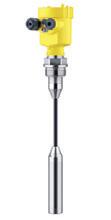

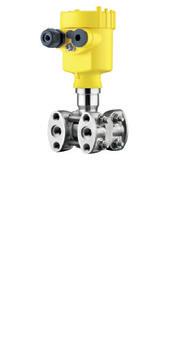

“Instrumentation may be a small part of large-scale construction projects, but it has a big impact,” says Tony Scarborough, business development manager for New South Wales at VEGA. “By getting involved early in the project lifecycle, we can help engineers avoid costly errors and ensure our technologies are integrated seamlessly into the broader operation.”
This focus on early engagement is a core part of VEGA’s strategy. According to Nick King, business development manager for South Australia and the Northern Territory, collaborating with engineers and contractors from the outset allows VEGA to tailor its solutions to specific project needs.
“Our goal is to provide certainty and repeatability in critical processes,” says King. “With our expertise, we can help clients achieve greater efficiency and reliability from day one.”
Municipal works and infrastructure projects are key areas for VEGA, with its systems already standardised by many local councils. From sewer and potable water networks to tunnelling and road construction, VEGA’s instrumentation is designed to perform in harsh environments, delivering consistent results that support sustainability and efficiency goals.
“Converge 2025 offers us a platform to amplify the importance of instrumentation,” says Scarborough. “Our technologies are indispensable when it comes to accuracy and efficiency. We look forward to connecting with industry leaders who share our vision for innovation and collaboration.”
With VEGA on board, Converge 2025 is set to shine a light on the often-overlooked yet indispensable tools that drive progress in major projects.
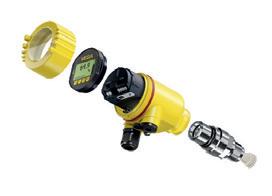

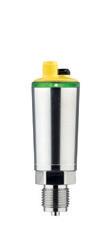
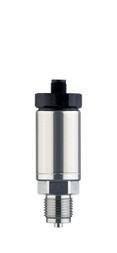








Inspired by its surroundings, this striking facade delivers more than harmony with its natural setting. Lightweight yet strong, TRUECORE® steel was the material of choice for the facade’s structure.

Fabricated to fine tolerances, the framing made from TRUECORE® steel structurally supports the large windows and mottled green roof tiles, while cleverly accommodating the flashings required for water management. The framing that seamlessly supports this beautiful facade was the winner of the 2022 Australian Steel Institute’s Innovative Cold Form Steel Building Award. Visit truecore.com.au to learn more.




